- Question Papers
- Scholarships

HRM Case Studies With Solutions
Let’s study Human Resource Management Case Studies with solutions. HRM Case studies play a vital role in management education especially in subjects like Human Resource Management (HRM), Personnel Management, PAAP and related subjects.
It gives a clear picture of the concepts when you practise them through case studies. Here we have given some live HRM case studies that are short, useful & interesting. This will allow you to think beyond the theoretical part and make you capable to apply the concepts in real-time situations.
Table of Contents
We are also providing solutions which are free of cost. We welcome your feedback about these HRM case studies.
Below are short and simple Case Studies on HRM with Solutions, Questions, and Answers.
HRM Case Study 1
Harsha and Franklin both of them are postgraduates in management under different streams from the same B-School. Both of them are close to each other from the college days itself and the same friendship is continuing in the organization too as they are placed in the same company, Hy-tech technology solutions. Harsha placed in the HR department as employee counsellor and Franklin in the finance department as a key finance executive. As per the grade is concerned both are at the same level but when responsibility is concerned Franklin is holding more responsibility being in core finance.
By nature, Harsha is friendly in nature and ready to help the needy. Franklin is silent in nature ready to help if approached personally and always a bit egoistic in nature. They have successfully completed 4 years in the organization. And management is very much satisfied with both of them as they are equally talented and constant performers.
Harsha felt that now a day’s Franklin is not like as he uses to be in the past. She noticed some behavioural changes with him. During general conversations, she feels that Franklin is taunting her that she is famous among the employees in the organization, on the other hand, he is not even recognized by fellow employees.
One morning Mr. Mehta General Manager Hy-tech technology solutions shocked while going through the mail received from Franklin about his resignation. Mr. Mehta called Harsha immediately and discussed the same as she is close to Franklin. By hearing the news Harsha got stunned and said that she does not know this before she also revealed here current experience with him. Mr. Mehta who does not want to lose both of them promised her that he will handle this and he won’t allow Franklin to resign.
In the afternoon Mr. Metha took Franklin to Canteen to make him comfortable after some general discussion he starts on the issue. Franklin, after some hesitation, opened his thinking in front of Mr. Mehta. The problem of Franklin is
1) when he comes alone to canteen the people from others don’t even recognize him but if he accompanied by Harsha he gets well treated by others.
2) one day Both of them entered the company together the security in the gate wished them but the next day when he came alone the same security did not do so.
3) Even in meetings held in the office, the points raised by Harsha will get more value so many times he keeps silent in the meeting.
It happens to Franklin that he has to face such degradation in each day of work which totally disturbs him. Franklin also questioned that ” Harsha and myself have the same qualification, from the same institute, passed out in the same year both with first class. We have the same number of experiences in this organization. Moreover, the responsibilities with me are more valuable than those of Harsha. After all these things if I am been ignored or unrecognized by the fellow employees my ego does not allow me to continue here”.
By listening to this statement Mr.Metha felt that it is not going to be very difficult to stop his resignation. Mr. Mehta explained Franklin the reasons for such partial behaviour of the employees. After listening to Mr. Mehta Franklin said sorry for his reaction and ready to take back his resignation. And he called Harsha and spoke with like before.
Questions for HRM Case Studies: Case Study 1
Find the reason that Mr. Mehta would have given to Franklin.
Solution for HRM Case Study 1
Mr. Mehta listening to this case understood the situation and realized the reason behind the partial response given by the employees towards Franklin and Harsha. As Franklin said both Harsha and Franklin are passed out from the same college in the same year. Both of them joined the company together both have the same experience. Even in performance-wise, both stands in the same level i.e. both are constant performers and good performers.
Franklin analyzed all the above-said similarities between him and Harsha. He also stated that he holds more responsibility than that of Harsha. One thing Franklin did not notice or analyzed is the job profile of Harsha. It is true that Franklin holds more responsibility than that of Harsha but when it comes to direct interaction with employees Harsha wins the employees’ attention in this aspect. Harsha being a counsellor in HR she faces the employees every day. She developed good rapport among the employees due to her friendly nature. She is always remembered by the employees whenever they face any problem as she gives good counselling and most of the time she suggests the best solutions for such issues.
Franklin though holding a key position in finance his profile does not allow him to interact with the employees. Though he has a helping tendency he does only when someone approached him personally. As the employees of other departments do not have any relation with him they never approach him for help. Mr. Mehta having a good experience understood these things when Franklin explained his problems one by one. Later he relates each situation, explained by Franklin with the above said reasons and made Franklin understood the reality.
Mr. Mehta said that the security in the gate or the employees in the canteen who recognized Harsha and not Franklin would have interacted with her during counselling or approached her for any issues. And as usual, she would have counselled well or solved the issues of them that is the reason why they treat her and wish her whenever where ever they meet her. When it comes to the case of Franklin they would have hardly met him or interacted with him.
When it comes to the point that even in-office meetings Harsha, points are valued so Franklin keeps mum. For this, Mr. Mehta replied that the points put forward by her would be related to employees or from the employees’ point of view which actually the management wants to know so they give value to her points. And as quoted Fraklin after, one or two such incidents keep silent in the meeting. He never made an attempt to raise some suggestions so management does not have any option to listen to that suggestion.
After listening to all the explanations given by Mr. Mehta Franklin realized his mistake and felt proud of the Rapport developed by Harsha among the employees. He said to Mr. Mehta that he will take back his resignation. And rushed to Harsha to make an apology and to meet her as a friend as like his college days.
HRM Case Studies Part 2:
HRM Case Study 2
Watson Public Ltd Company is well known for its welfare activities and employee-oriented schemes in the manufacturing industry for more than ten decades. The company employs more than 800 workers and 150 administrative staff and 80 management-level employees. The Top-level management views all the employees at the same level. This can be clearly understood by seeing the uniform of the company which is the Same for all starting from MD to floor level workers. The company has 2 different cafeterias at different places one near the plant for workers and others near the Administration building. Though the place is different the amenities, infrastructure and the food provided are of the same quality. In short, the company stands by the rule of Employee Equality.
The company has one registered trade union. The relationship between the union and the management is very cordial. The company has not lost a single man day due to strike. The company is not a paymaster in that industry. The compensation policy of that company, when compared to other similar companies, is very less still the employees don’t have many grievances due to the other benefits provided by the company. But the company is facing a countable number of problems in supplying the materials in the recent past days. Problems like quality issues, mismatch in packing materials (placing material A in the box of material B) incorrect labelling of material, not dispatching the material on time, etc…
The management views the case as there are loopholes in the system of various departments and hand over the responsibility to the HR department to solve the issue. When the HR manager goes through the issues he realized that the issues are not relating to the system but it relates to the employees. When investigated he come to know that the reason behind the casual approach by employees in work is
- The company hired new employees for a higher-level post without considering the potential internal candidates.
- The newly hired employees are placed with higher packages than that of existing employees in the same cadre.
- Narrate the case with a suitable title for the case. Justify your title.
Solution for HRM Case Case Study 2
Employee Equality is not the need for every hour. In the above-said case, Watson Ltd had provided all facilities to employees at each grade in an equal manner. But still, the employees started creating certain issues like materials are meeting the quality supply schedule is not met etc. And the HR manager said that the policy of hiring new employees for the higher post without considering old potential employees is the major problem.
“Employee recognition VS Employee equality ”. As the HR manager states that employees are not been recognized for the potential rather the company has gone for new recruitment. Because of which the company faces problems.
- The points rose by the HR manager as the reason for the latest issues in the organization is justifiable or not. Support your answer with Human resource related concepts.
Yes, the points raised by the HR manager is justifiable because “Human beings are social Animals as popularly” said by many Human resources Scholars. So human minds demand social recognition, self-respect, consideration, etc for their work and performance.
In the above-said case, even the company provides and stands by the concept of employee equality when it fails to recognize the potential talents of existing employee they felt dissatisfaction towards the organization and they showed in the way of quality issues and slow down production.
Related HR concept.
Slow down Production:
The concept of slow down production is a type of employee’s strike. The Industrial Relations sates that when the employee wants to show their dissatisfaction to the management but don’t want to go for strike they follow slow down strike. The impact of which will be understood after a particular time period.
Employee Recognition:
Human beings can be easily motivated by Rewards and recognition than that of money. In this case, also the employee is not satisfied even after all facilities just because of the reason that they are not recognized.
Hawthrone Experiment:
In the four types of test conducted by Elton Mayo, the remarkable hike in production is recognized in the stage when they consulted the employees for the management decisions regarding them. The same thing was missing in Watson Ltd. Before the new hires if the management consulted the employees both management and employees would have avoided this issue
Hygiene Factor:
The theory of hygiene factors states that there are certain factors related to employees the presence of which will not create a major impact but the absence of such things will lead to a de motivation to the employees. Employee Recognition is one such factor when the management fails to do so it will Detroit the employees to a great extent.
- Help the organization to come out from this critical issue. If you are in the role of HR manager what will be your immediate step to solve this case.
If I was in the post of the HR manager I will try to discuss the issue and ask for the reason from the management for new recruiting rather than considering available potential talents. I will personally analyse the reasons provided by management and if acceptable I will discuss the same with the employees. Everything is possible with a discussion. So I will discuss and convince the employee that this won’t happen again in the organization. I will also initiate the collective bargaining process for reasonable salary hike for the existing employees.
How to Download PDF of HRM Case Studies
You can copy and use this text for personal use.
This is all about HRM Case Studies with solutions. You can contact us for the PDF or PPT format.
You’ll also like Top 25 Human Resource Management MCQ With Answers (Updated)
Share with friends
A Guide to Human Resources Management Case Studies
Published by hr consultants on january 26, 2024 january 26, 2024.
Human Resource Management case studies provide valuable insights into the challenges faced by HR professionals in diverse workplaces. In this comprehensive guide, we will explore real-life examples of HRM in action, showcasing the strategies and solutions implemented to tackle various HR challenges.
Key Takeaways:
- Human Resources Management Case Studies offer practical insights for HR professionals.
- Real-life examples highlight strategies and solutions for overcoming HR challenges.
- Case studies showcase the importance of effective HR strategies in organizational success.
- Diverse scenarios demonstrate the application of HRM practices in different workplaces.
- Continuous learning and adaptation are crucial for HR professionals to stay effective.
The Changing Landscape of HRM
In the rapidly evolving global business environment, Human Resources Management (HRM) is constantly adapting to new trends and challenges. From the emergence of emerging markets to the digitalization of workplaces, HR professionals have had to navigate through various obstacles to effectively manage their workforce. One of the most significant challenges in recent times has been the global COVID-19 pandemic, which has necessitated swift and innovative HR strategies.
To gain a deeper understanding of how organizations have successfully managed these changes and optimized their HR practices, we will delve into a range of case studies. These case studies provide valuable real-world examples that HR professionals can analyze and apply in their own organizations. By studying these HR case studies , professionals can learn from the experiences of others, gaining insights into successful strategies and approaches.
Utilizing HR case studies for analysis allows us to discover how organizations have leveraged HRM to overcome obstacles and adapt to new circumstances. These real-life examples showcase the diverse ways in which organizations have effectively managed HR challenges, providing valuable lessons and strategies for HR professionals across industries.
Company XYZ, a multinational technology firm, faced challenges in attracting and retaining top talent due to the fast-paced nature of the industry. To address this, they implemented a strategic HR initiative that focused on creating a flexible work environment, providing opportunities for professional development, and offering competitive compensation packages. As a result, the company experienced a significant reduction in employee turnover and an increase in employee satisfaction and productivity.
This case study highlights how HR professionals at Company XYZ were able to adapt to the changing landscape of HRM by implementing innovative strategies. By analyzing such success stories, HR professionals can gain valuable insights into the strategies and practices that drive organizational success.
- HRM is constantly evolving to respond to new trends and challenges in the business world.
- Case studies provide real-world examples of effective HR practices in managing change.
- Successful organizations leverage HRM strategies to optimize their workforce and drive organizational success.
The Importance of Effective HR Strategies
Effective HR strategies are crucial for organizations to attract, retain, and develop top talent. By implementing strategic HR practices, companies can create a positive work environment that fosters employee engagement, productivity, and overall organizational success. In this section, we will explore case studies that highlight successful HR strategies implemented by companies across different industries, providing valuable insights for research and inspiration.
Case Studies: Success Stories in HR Management
Case Study 1: Company X
“Our HR strategy of prioritizing employee well-being and work-life balance has had a significant impact on our organizational culture. Through flexible work arrangements, wellness programs, and regular communication channels, we have seen a remarkable increase in employee satisfaction and productivity.”
Case Study 2: Company Y
“By investing in employee development and career progression, we have been able to attract top talent and retain key employees. The implementation of mentorship programs, training initiatives, and performance feedback systems has led to higher employee engagement and a stronger talent pipeline.”
Case Study 3: Company Z
“Our HR strategy focuses on promoting a diverse and inclusive workforce. Through targeted recruitment efforts, diversity training programs, and inclusive policies, we have successfully created a culture that celebrates and values diversity, leading to improved employee satisfaction and innovation.”
The Impact of Strategic HR Practices
These success stories demonstrate the tangible benefits of strategic HR practices. Organizations that prioritize effective HR strategies are better equipped to attract and retain top talent, foster employee engagement and satisfaction, and drive overall organizational success. By studying these case studies, researchers and HR professionals can gain valuable insights and inspiration to enhance their own HR practices and achieve similar levels of success.
By examining these HRM case studies for research and guidance, organizations can adopt successful strategies and adapt them to their unique contexts. The implementation of effective HR strategies is key to creating a thriving workplace culture that empowers employees, maximizes productivity, and ultimately drives the success of the organization.
Fundamental Concepts of HR Management
Before diving into Human Resources Management Case Studies , it is essential to have a solid understanding of the fundamental concepts that underpin HR management. This section will explore key definitions and concepts to provide a strong foundation for in-depth analysis of the case studies.
Definitions and Clarifications
Let’s start by clarifying some key terms:
- Management : Refers to the process of coordinating and overseeing organizational resources to achieve specific goals and objectives.
- Resources : In the context of HR, resources refer to the individuals who contribute to the organization’s success, including employees, contractors, and other stakeholders.
- Role of a Manager : A manager is responsible for planning, organizing, directing, and controlling resources to achieve organizational goals and objectives. In the HR context, managers focus on effectively managing human resources.
- Difference between Management and Administration : While the terms management and administration are sometimes used interchangeably, it is important to note the subtle distinctions. Management is concerned with the implementation of strategies and the coordination of resources, whereas administration involves the overarching policies, procedures, and regulations that govern the organization.
By understanding these fundamental concepts, we can delve deeper into the case studies and gain valuable insights into the challenges and solutions faced by HR professionals.
Inspiring Quote
“Management is doing things right; leadership is doing the right things.” – Peter Drucker
Key Definitions
Management functions and responsibilities.
Effective management is essential for HR professionals in their role of overseeing an organization’s human capital. Understanding the four basic functions of management – planning, organizing, directing, and controlling – is critical for HRM success. Each function contributes to the efficient and effective management of human resources, ensuring organizational goals are met.
In addition to these management functions, HR managers have specific responsibilities that contribute to the overall success of the organization. These responsibilities include:
- Recruitment and selection of qualified candidates
- Employee onboarding, training, and development
- Creating and enforcing HR policies and procedures
- Ensuring legal compliance in all HR practices
- Managing employee relations and resolving conflicts
- Designing and administering compensation and benefits programs
- Developing and implementing employee engagement initiatives
- Overseeing performance management and evaluation processes
Furthermore, HR plays a vital role in the administrative cycle of an organization. HR professionals are responsible for managing and maintaining accurate HR records, handling payroll and benefits administration, and ensuring compliance with employment laws and regulations.
By effectively executing their management functions and fulfilling their responsibilities, HR professionals contribute to the development and success of an organization’s human resources, driving overall organizational performance and productivity.
Skills and Competencies in HR Management
The success of an HR manager relies on a combination of technical skills and personal qualities. Understanding and mastering these essential skills and competencies is crucial for effectively managing human resources in any organization. Here, we will explore the key characteristics that distinguish an effective HR manager and how they contribute to success in HR management.
1. Integrity
Integrity is the foundation of trust in any HR department. HR managers must demonstrate honesty, transparency, and ethical behavior in all aspects of their work. By upholding high ethical standards, HR managers cultivate a culture of integrity, ensuring fair and unbiased treatment of employees and fostering a positive work environment.
2. Flexibility
Flexibility is essential in an ever-changing business landscape. HR managers must adapt to evolving workplace dynamics, industry trends, and technological advancements. This includes being open to new ideas, embracing change, and continuously updating HR strategies to align with organizational goals and employee needs.
3. Resilience
HR managers often face challenging situations that require resilience and the ability to navigate complex issues. They must stay composed in difficult times, effectively manage conflicts, and find creative solutions to address HR challenges. Resilient HR managers are invaluable assets to organizations, as they can lead teams through change and uncertainty, ensuring continuity and stability.
4. Proactivity
Successful HR managers are proactive in identifying potential issues before they escalate. They anticipate future needs and create proactive strategies to address them. By staying ahead of the curve, HR managers can plan and implement initiatives that support employees’ growth, well-being, and overall job satisfaction.
“Proactive HR managers take a proactive approach to identify potential pitfalls early on, allowing organizations to prevent problems rather than just managing them when they arise.”
In addition to these personal qualities, HR managers must possess a range of technical skills to effectively manage human resources. Some of these skills include:
- Recruitment and selection
- Training and development
- Performance management
- Employee relations
- Compensation and benefits
- HR data analysis
To exemplify these skills and competencies, let’s take a look at a real-life HR case study:
By analyzing such HR case studies , aspiring HR professionals and organizations can gain valuable insights into the practical application of skills and competencies in HR management.
Now that we have explored the essential skills and competencies in HR management, it is clear that successful HR managers possess a unique blend of personal qualities and technical skills. These individuals play a vital role in driving organizational success by effectively managing human resources and fostering a positive work environment.
Employee Motivation and Engagement
Motivated and engaged employees are essential for organizational success. In this section, we will explore the crucial role of HR in motivating employees and fostering a culture of engagement. By examining real-life case studies, we will identify effective strategies and initiatives implemented by organizations to boost employee motivation and engagement.
Motivation through Recognition
Employee recognition is a powerful tool for motivating and engaging employees. Organizations that prioritize recognition programs create a culture of appreciation and reinforce desired behaviors. Case studies highlight the impact of tailored recognition programs on employee satisfaction, morale, and performance.
Professional Development and Growth
Providing opportunities for professional development and growth is another key driver of employee motivation and engagement. Organizations that invest in training, mentorship programs, and career advancement opportunities empower employees to enhance their skills and fulfill their potential. Real-life examples demonstrate how these initiatives contribute to higher employee satisfaction and loyalty.
Well-being Initiatives
Employee well-being initiatives play a vital role in nurturing a positive work environment and enhancing motivation. By offering wellness programs, flexible work arrangements, and promoting work-life balance, organizations prioritize the holistic well-being of their employees. Case studies highlight the positive impact of these initiatives on employee engagement, productivity, and overall satisfaction.
Effective Communication
Open and transparent communication is integral to fostering motivation and engagement among employees. Organizations that prioritize effective communication channels, including regular feedback, town hall meetings, and collaborative platforms, create an environment of trust and inclusion. Real-life examples demonstrate how improved communication positively influences employee engagement and overall organizational performance.
“Effective employee motivation and engagement are the cornerstones of a thriving organization. By examining real-life case studies, HR professionals and organizations can gain valuable insights into successful strategies and initiatives that fuel motivation and foster meaningful employee engagement.”
The case studies above demonstrate how organizations have successfully implemented strategies to motivate and engage their employees. By leveraging recognition, professional development, well-being initiatives, and effective communication, these organizations have created a positive work environment that drives employee satisfaction, productivity, and loyalty.
Strategies for Effective HR Management
HR professionals play a critical role in developing and implementing effective HR strategies. By analyzing real-life case studies, we can gain valuable insights into HR best practices. These case studies highlight successful strategies in key areas such as:
Recruitment and Selection
Training and development, performance management, compensation and benefits, labor relations.
Let’s explore how organizations have utilized these strategies to optimize their HR practices and achieve their business objectives.
“The key to effective HR management lies in understanding the unique needs and challenges of your organization. By analyzing case studies, we can gain valuable insights and tailor our strategies to drive employee engagement, productivity, and organizational success.”
Effective recruitment and selection processes are crucial for attracting and hiring top talent. Case studies in this area often showcase innovative methods used to identify and attract qualified candidates. From leveraging technology platforms for applicant screening to implementing targeted recruitment campaigns, organizations have successfully optimized their hiring processes.
Investing in employee training and development is essential for enhancing skills and fostering long-term growth. By examining case studies in this domain, we can learn from organizations that have successfully implemented comprehensive training programs, mentorship initiatives, and continuous learning platforms. These strategies contribute to a skilled and motivated workforce.
Effective performance management systems align individual and team goals with organizational objectives. Case studies in this area often highlight organizations that have implemented performance measurement frameworks, regular feedback systems, and performance-based incentives. This data-driven approach ensures transparency, fairness, and continuous improvement.
Strategic compensation and benefits programs attract, retain, and motivate talented employees. Case studies demonstrate how organizations have designed competitive salary structures, employee recognition programs, and comprehensive benefits packages. These initiatives contribute to higher employee satisfaction, engagement, and overall organizational performance.
Managing labor relations requires effective communication, negotiation, and conflict resolution skills. Case studies in this area offer insights into organizations that have successfully fostered positive relationships with unions, implemented fair labor practices, and resolved labor disputes amicably. These examples highlight the importance of proactive labor management strategies.
By learning from these case studies and applying the demonstrated strategies, HR professionals can optimize their HR management practices and create a positive impact on organizational success.
These case studies showcase the application of effective HR management strategies in different organizations. They provide practical examples of how organizations have achieved success by implementing various strategies tailored to their unique needs and challenges.
Leveraging HR Technology
HR technology has revolutionized HRM processes, enabling organizations to streamline operations and enhance efficiency. By leveraging the power of technology, HR professionals can optimize their strategic decision-making and ensure a seamless employee experience.
Let’s examine some insightful case studies that illustrate the successful implementation and utilization of HR technology. These examples demonstrate how organizations have harnessed the potential of HRIS (Human Resource Information System), talent management software, and data analytics tools to drive meaningful outcomes and achieve their HR objectives.
Case Study 1: Enhancing Recruitment with HRIS
In this case study, Company ABC implemented an HRIS software to streamline their recruitment process. The software automated job posting, applicant tracking, and resume screening, significantly reducing the time and effort spent on manual tasks. With the implementation of HRIS, the HR team at Company ABC experienced a 40% reduction in time-to-hire and an improvement in the quality of hires.
“The HRIS software has transformed our recruitment process, allowing us to focus on strategic talent acquisition. The automation and advanced analytics capabilities have enabled us to make data-driven decisions and hire top talent efficiently.” – Sarah Thompson, HR Manager, Company ABC
Case Study 2: Optimizing Performance Management with Talent Management Software
In this case study, Company XYZ adopted a talent management software platform to streamline their performance management process. The software offered features such as goal setting, continuous feedback, and performance analysis, empowering managers and employees to take a more proactive approach to performance improvement. As a result, Company XYZ experienced a significant increase in employee engagement and aligned performance goals across the organization.
“The talent management software has revolutionized our performance management process. It has fostered a culture of continuous feedback and empowered our employees to take ownership of their professional growth. The transparent performance analytics have enabled us to identify and reward top performers effectively.” – John Davis, HR Director, Company XYZ
Case Study 3: Leveraging Data Analytics for Strategic Decision-Making
In this case study, Company DEF implemented advanced data analytics tools to gain insights into their HR processes. By analyzing data related to employee engagement, turnover rates, and performance metrics, the HR team at Company DEF could identify trends, patterns, and areas for improvement. This strategic use of data analytics enabled Company DEF to make informed decisions and implement targeted HR interventions, resulting in improved retention rates and increased productivity.
“Data analytics has been a game-changer for our HR department. By leveraging actionable insights from our HR data, we have been able to proactively address employee concerns, enhance our talent acquisition strategies, and design targeted training programs. Our data-driven approach has significantly contributed to our overall organizational success.” – Lisa Johnson, HR Manager, Company DEF
These case studies demonstrate how organizations can harness the potential of HR technology to drive efficiency, improve decision-making, and enhance the employee experience. By leveraging the right combination of HRIS, talent management software, and data analytics tools, HR professionals can transform their HR practices and contribute to the strategic objectives of the organization.
Leveraging HR technology is essential in today’s digital era, where technology continues to shape the future of work. By staying informed about the latest HR technology trends and exploring case studies, HR professionals can identify opportunities for innovation and drive impactful HR initiatives.
Now, let’s explore another critical aspect of HR management – diversity and inclusion.
Diversity and Inclusion in HR Management
In today’s diverse workforce, creating an inclusive environment is essential for effective human resources management. Organizations that prioritize diversity and inclusion benefit from improved employee satisfaction, increased productivity, and enhanced innovation. Let’s explore some real-life examples of HRM case studies that highlight the successful efforts of organizations to foster diversity and inclusion within their workforce.
Case Study 1: XYZ Company
XYZ Company, a global technology firm, recognized the value of diversity and inclusion in driving organizational success. They implemented a comprehensive diversity program that focused on recruiting and retaining employees from diverse backgrounds. By promoting a culture of inclusion through training, mentorship, and employee resource groups, XYZ Company witnessed a significant increase in employee engagement and creativity. This case study demonstrates the positive impact of diversity and inclusion initiatives on overall organizational performance.
Case Study 2: ABC Corporation
ABC Corporation, a leading retail company, recognized the importance of diversity and inclusion in meeting the needs of their diverse customer base. They implemented unconscious bias training for their hiring managers and implemented policies to ensure equal opportunities for all employees. As a result, ABC Corporation experienced improved employee satisfaction, reduced turnover rates, and a boost in customer loyalty. This case study exemplifies the positive outcomes that can be achieved through a commitment to diversity and inclusion in HR management.
By analyzing these HRM case studies , organizations can gain valuable insights into successful diversity and inclusion initiatives. Implementing similar strategies, such as targeted recruitment efforts, inclusive policies, and diversity training programs, can help companies create a more inclusive and diverse workforce, fostering a culture of innovation and success.
Incorporating diversity and inclusion into HR management practices is not only a legal and moral imperative, but it also leads to tangible business benefits. Organizations that embrace diversity and create an inclusive workplace are better equipped to attract top talent, retain employees, and drive innovation. By learning from these HRM case studies , organizations can develop effective strategies to foster diversity and inclusion, ultimately contributing to their long-term success.
Adapting HR Practices in Times of Crisis
In times of crisis, such as economic downturns or natural disasters, HR professionals face unique challenges that require them to adapt their practices quickly and effectively. By analyzing HRM case studies that showcase organizations’ responses to crises, we can gain valuable insights into the strategies and approaches they employed to navigate through turbulent times and emerge stronger.
The Importance of Flexibility
One key lesson we can learn from HR case studies in times of crisis is the importance of flexibility. Organizations need to be agile and responsive to rapidly changing circumstances. HR professionals play a vital role in proactively adjusting HR practices, policies, and procedures to meet the immediate needs of employees and the organization as a whole.
“During the global financial crisis of 2008, XYZ Corporation faced severe economic challenges that threatened its survival. The HR team swiftly implemented cost-cutting measures, including a freeze on hiring and salary reductions, while carefully balancing employee morale and engagement. Through open communication and transparent decision-making, XYZ Corporation managed to weather the storm and emerge with a more resilient workforce.”
By adopting a flexible approach, HR professionals can help organizations navigate through turbulent times, mitigate the impact on employees, and position the company for recovery and future growth.
The Power of Resilience
Resilience is another critical factor in adapting HR practices during a crisis. HR professionals need to demonstrate resilience in the face of uncertainty and guide employees through challenging times. By instilling confidence, providing support systems, and fostering a sense of unity, HR managers can help organizations withstand the pressures of a crisis and emerge stronger.
Resilience can be seen in action through the implementation of employee assistance programs, mental health initiatives, and crisis communication plans. These measures help employees navigate the emotional and psychological challenges brought on by the crisis, ensuring their well-being and enabling them to contribute effectively to the organization’s recovery efforts.
Proactive Planning for Future Crises
The best HR case studies in times of crisis highlight the importance of proactive planning. While crises may be unexpected, organizations can anticipate potential challenges and develop contingency plans to address them swiftly and efficiently. By anticipating various scenarios and regularly reviewing and updating crisis response strategies, HR professionals can position their organizations for success even in the face of uncertainty.
In addition to crisis preparedness, proactive planning involves identifying key skills and competencies that will be crucial in future crises. By integrating training programs, succession planning, and talent management initiatives into their HR practices, organizations can ensure they have the capabilities necessary to navigate through any crisis that may arise.
Table: Strategies for Adapting HR Practices in Times of Crisis
Adapting HR practices in times of crisis requires a combination of flexibility, resilience, and proactive planning to ensure the well-being of employees, maintain productivity, and secure the organization’s long-term success.
Human Resources Management Case Studies provide HR professionals with valuable insights into real-world challenges and innovative solutions. By analyzing these examples, organizations can learn from best practices and optimize their own HR strategies. The showcased case studies highlight the diverse scenarios that HR professionals face and the creative approaches they employ to overcome obstacles.
Continuous learning from these experiences enables HR professionals to enhance their skills and contribute to the overall success of their organizations. These case studies serve as a source of inspiration, demonstrating the importance of adaptability, strategic thinking, and effective HR management.
By embracing the lessons learned from Human Resources Management Case Studies, HR professionals can strengthen their expertise, foster employee engagement, and drive organizational growth. These real-life examples reaffirm the significance of HRM for businesses in today’s dynamic and ever-evolving corporate landscape.
Source Links
- https://www.shrm.org/credentials/certification/educators/teaching-resources
- https://www.e-elgar.com/shop/usd/case-studies-in-work-employment-and-human-resource-management-9781788975582.html
- https://gfoundry.com/everything-you-need-to-know-about-human-resources-a-manual-for-managers-and-professionals/
Leave a Reply Cancel reply

Your email address will not be published. Required fields are marked *
Save my name, email, and website in this browser for the next time I comment.
Related Posts

The Role of Employee Leasing in Modern Businesses
Uncover the transformative power of employee leasing in reshaping modern businesses, revolutionizing workforce dynamics and organizational culture.

Employee Bonuses: How to Calculate and Distribute Fairly
Baffled about the fairness of your employee bonus structure? Discover how to ensure equity and motivation in calculating and distributing bonuses.

Employee Performance: Coaching and Managing Bad Attitudes
Just when you think all hope is lost, there might be a game-changing strategy to tackle bad attitudes in the workplace.
This site uses cookies to improve your experience. By viewing our content, you are accepting the use of cookies. To help us insure we adhere to various privacy regulations, please select your country/region of residence. If you do not select a country we will assume you are from the United States. View our privacy policy and terms of use.
- Employee Benefits
- Change Management
- Talent Acquisition
- Applicant Tracking Systems

7 Steps to Building a Successful Talent Acquisition Team (+Netflix Case Study)
Analytics in HR
AUGUST 8, 2023
Talent acquisition team structure Examples of organizations’ talent acquisition team structures 7 Steps for building a talent acquisition team How to measure the success of a talent acquisition team Case study : Netflix’s talent acquisition team What is a talent acquisition team?
15 HR Analytics Case Studies with Business Impact
NOVEMBER 5, 2018
For this article, I have collected 15 of the best HR analytics case studies I’ve come across in the past two years. Each of these case studies are connected with a concrete business impact. For each case study , I will refer to their original publication. 15 HR Analytics Case Studies .
This site is protected by reCAPTCHA and the Google Privacy Policy and Terms of Service apply.
- The Engagement Engine: Strategies for Building a High-Performance Culture
- From Awareness to Action: An HR Guide to Making Accessibility Accessible
- Unlocking Employee Potential with the Power of Continuous Feedback
MORE WEBINARS
Trending Sources
- EmployeeConnect
DecisionWise
- Engage2Excel
- PeopleStrategy
- UrbanBound HR

Children’s Mercy Hospital Case Study
Stories Incorporated HR
APRIL 8, 2020
Want this case study as a PDF? For example , nursing job descriptions now start with a call to action, not to apply, but to watch a video to hear the experiences of their nursing staff. The post Children’s Mercy Hospital Case Study appeared first on Stories Incorporated. Reading Time: 6 minutes.

New i4cp Case Study Explores Humana’s Innovations in Virtual Volunteerism (i4cp login required)
DECEMBER 15, 2020
An i4cp member company that continues to contribute insights and examples to the research on well-being, Humana is pioneering innovative approaches that enable its employees (“associates”) to continue participating in philanthropic efforts when face-to-face or high-touch settings aren’t viable options. Few answers were forthcoming.

Case Study: Strategic Workforce Planning for Rail Infrastructure Managers
MARCH 30, 2020
In this case study , strategic workforce planning is applied to solve this national problem, impacting millions of commuters. The post Case Study : Strategic Workforce Planning for Rail Infrastructure Managers appeared first on AIHR Analytics. This requires tremendous changes in the current workforce. Curious how?

PayParity Pay Equity Case Study: Mother Jones
SEPTEMBER 6, 2022
For example , aside from equitable pay being the right thing to do, regularly conducting transparent audits can help boost employee trust in the company, which in turn can help improve retention. This case study was originally published in our partner ADP’s Spark blog. “We verified the information from 2021 data. .

What is HR Analytics? All You Need to Know to Get Started
FEBRUARY 28, 2024
Importance of HR analytics HR analytics examples Key HR metrics Data analytics in HR: How to get started How to transition from descriptive to predictive and prescriptive analytics in HR HR analytics certification FAQ What is HR analytics? Example : Annual employee turnover rate.) We discuss more real-life examples below.

Case Study: MarketGap’s Innovative Strategy for Agile Workforce Evolution
JUNE 30, 2023
Case Study : Rapid Transformation When MarketGap realized the need for digital transformation and a more dynamic online presence, they turned to freelancers for their expertise in innovation and experimentation. The post Case Study : MarketGap’s Innovative Strategy for Agile Workforce Evolution appeared first on Hppy.

Case Study: Designing HIPO Programs That Work
Chief Learning Officer - Talent Management
AUGUST 10, 2021
For example , a senior executive can provide clarity to how the competencies in talent management would show up in associate vice presidents or senior directors. Each session has a short case study that directly relates to the topic. These same individuals can have similar conversations with their direct reports.
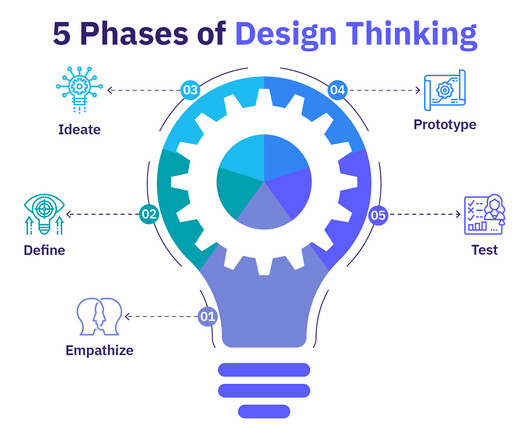
How To Apply Design Thinking in HR (+ 3 Case Studies)
AUGUST 16, 2023
The benefits of a design thinking approach in HR The 4 principles and 5 phases of design thinking 4 Ways to apply design thinking to HR processes Successful implementation of design thinking in HR Design thinking in HR examples What is design thinking? The post How To Apply Design Thinking in HR (+ 3 Case Studies ) appeared first on AIHR.
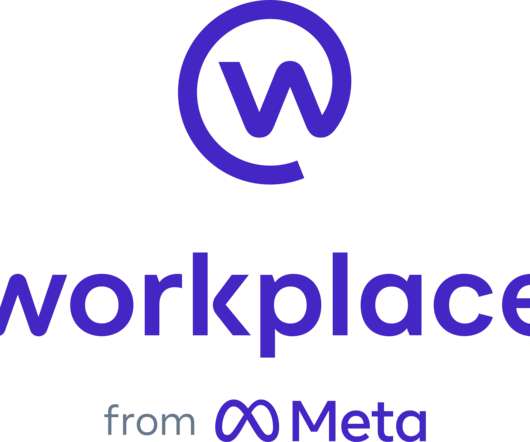
How Mayo Clinic Selects Leaders: A Case Study
AUGUST 19, 2022
Kang also suggests how to evaluate if leaders are actually successful or not, offering examples that help to make this conversation very practical for companies that want to use their leaders to engage, develop, and retain their workforce. . . This episode is sponsored by Workplace from Meta. . .

13+ HR Case Studies: Recruiting, Learning, Analytics, and More
SEPTEMBER 3, 2019
As someone who has worked in the HR profession, I know well the full value of stories, examples , and case studies . While much of the work we do at Lighthouse Research & Advisory focuses on quantitative research studies , we do a fair amount of qualitative research as well.

The Power of People: A Case Study on Power PEO Consulting’s Selection of ExtensisHR
AUGUST 28, 2023
Download the full case study to learn more. >> As an industry veteran, he maintains a strong portfolio of PEOs and knew of ExtensisHR’s reputation for customer service, human capital management, and ability to engineer custom PEO solutions.
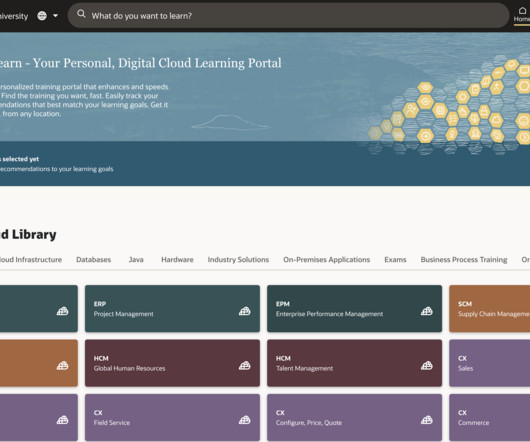
20 Learning Management System Examples
FEBRUARY 29, 2024
Discover 20 top Learning Management System examples in our comprehensive guide. Explore LMS case studies and resources. Choose the right LMS for your needs.
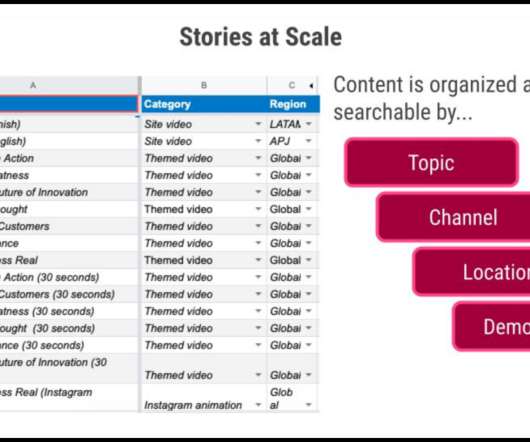
Organizational Storytelling Case Study: Dell Technologies
JULY 5, 2022
Reading Time: 3 minutes This organizational storytelling case study is an excerpt from our download, The Complete Guide to Organizational Storytelling. For example , in one year, the Stories Inc. The post Organizational Storytelling Case Study : Dell Technologies appeared first on Stories Incorporated.
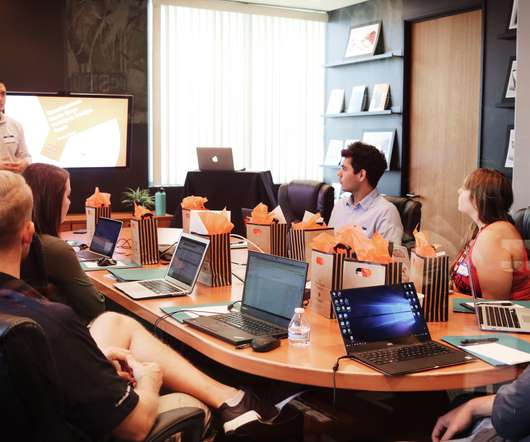
HR Trends and Case Studies
Effortless HR
JANUARY 20, 2022
These case studies and HR trends 2021 show how the future of work might look as we approach 2022. For example , some companies use online analytics tools to chart employee participation, online activity, and engagement in virtual meetings. HR Trends Throughout 2020-21. Working From Home. Data Analysis of Workforce.
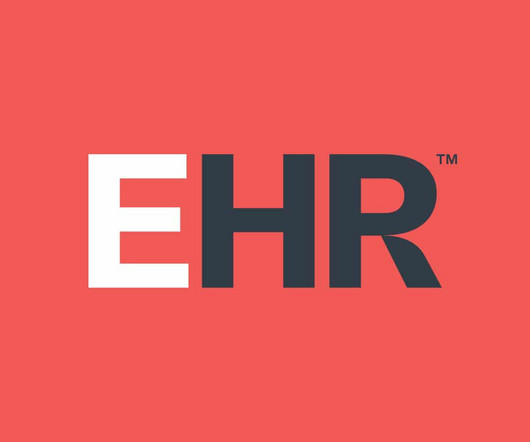
JULY 31, 2023
As an industry veteran, he maintains a strong portfolio of PEOs and knew of ExtensisHR’s reputation for customer service, human capital management, and ability to engineer custom PEO solutions. He reached out soon after founding Power PEO Consulting and quickly forged a partnership.

Varda Chocolatier: Customer Interview & Case Study
FingerCheck
OCTOBER 6, 2022
Varda Chocolatier: Customer Interview & Case Study . I’ve built that relationship, like for example , I speak to Jeremy a lot. For example , pushing payrolls for the next day is very fair and reasonable and I think recently they released that I could be having 8 p.m., Access Case Study .

[CASE STUDY] Transforming Organizational Culture
Civility Partners
JUNE 10, 2021
We recently put together a case study regarding one of our clients, Rainbow Municipal Water District (RMWD), and thought we’d share it in case you were looking for ideas on improving your own workplace culture. The post [ CASE STUDY ] Transforming Organizational Culture appeared first on Civility Partners.

OKR Examples: How to Write OKRs that Drive Impact
OCTOBER 19, 2022
In this article, we’ll break down the framework for writing impactful objectives and key results and share some OKR examples you can use as a guide when crafting your own. Example of a poorly-written objective: Provide better customer service. Example of poorly-written key results: Treat our customers well every day.

Case Study: Manufacturing Client Connects Frontline Employees
MAY 2, 2022
For example , employees were asked, “which shifts can you help out with?” Yes, sign me up to receive tips, case studies , and other helpful materials! Δ The post Case Study : Manufacturing Client Connects Frontline Employees appeared first on Bonfyre. Work email *.

Talent Mobility Case Studies and Research [Podcast]
DECEMBER 7, 2016
In addition, I examine some case studies and examples of companies that are doing interesting work with talent mobility, including World Bank Group, Chipotle, and Hootsuite.

Recruiting Feedback Case Study: The Recruiting Revenue Connection
MARCH 11, 2019
In our latest recruiting feedback case study , Craft Brew Alliance (CBA) demonstrates that asking the right questions at the right time can dramatically affect overall recruiting effectiveness AND uncover powerful connections between recruiting and revenue generation. Download the Case Study for More.

Case Study: Credit Union
OCTOBER 1, 2020
Today’s case study explains how TimeSimplicity can help a typical small credit union maintain quality customer service while controlling operating expenses through automated credit union employee scheduling. Our example organization is Springfield Community Credit Union. How much can you save? ArticleID 7414.

Case Study: Bonfyre helps call center leaders to engage teams in a remote setting
APRIL 27, 2023
For example , Bonfyre can be used to share training materials, facilitate DEI discussions, and recognize employees for their diversity and inclusion efforts. Yes, sign me up to receive tips, case studies , and other helpful materials! Bonfyre is increasing awareness and impact of learning, DEI, and other programs.
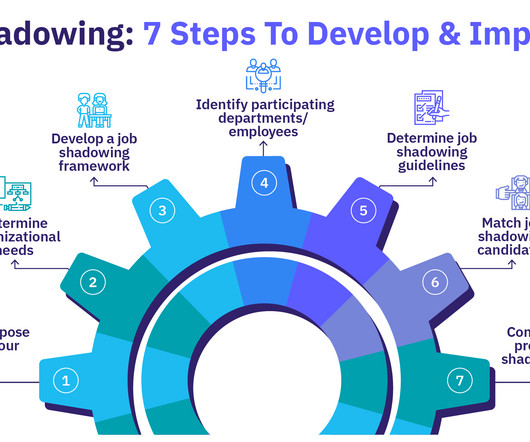
Your In-Depth Guide to Implementing Job Shadowing (+ Google Case Study)
AUGUST 14, 2023
Benefits of job shadowing Types of job shadowing Developing and implementing a job shadowing program: 7 Steps Real-life job shadowing example : Google’s G2G job shadowing program Stay interview best practices Tips for successful job shadowing What is job shadowing? Contents What is job shadowing?
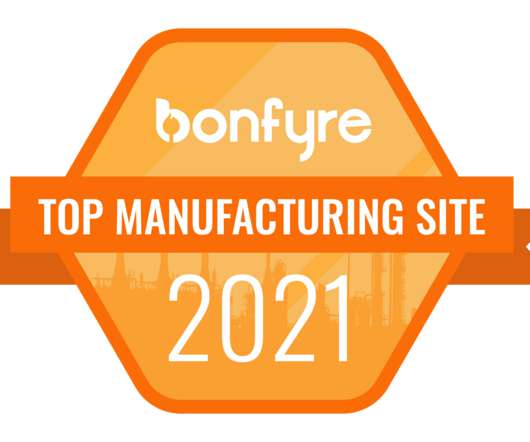
Case Study: How Bonfyre’s Top Manufacturing Site Improved Employee Engagement?
AUGUST 11, 2022
For example , they share site and facilities updates, real-time crisis updates and resolutions, system updates, upcoming events and leadership communications. Yes, sign me up to receive tips, case studies , and other helpful materials! Please indicate if you are in the EU (GDPR). Bonfyre is committed to your privacy.

Are You Throwing Your Employees Under the Bus? [Case Study] - DecisionWise
AUGUST 1, 2017
A Case Study on Improving The Customer Experience (CX) at the Risk of The Employee Experience (EX). In this case study we examine how the Chicago Transit Authority sought to improve its Customer Experience while failing to focus on its Employee Experience. Case Study ] appeared first on DecisionWise.

Case Study: The Value Of Pay Transparency And How To Implement It
HR Tech Girl
JULY 5, 2023
Here I aim to shed light on what pay transparency looks like at Compt, explain its mechanics and influence on overall compensation structures and raises, present real-world examples of its benefits, and provide practical considerations for organizations contemplating this approach.

Case Study: Growing Your Sales Organization Beyond The Deal
MARCH 16, 2017
In the following case study , you will learn how a high-growth company uses a software solution to respond to these challenges. For example , responses to “what are you hearing about our competition?” For example , his SDRs are capturing all of the biggest objections that they receive early in the sales cycle.

Case study: Executing a recruitment marketing video plan
MAY 19, 2021
This case study is an excerpt from our new ebook, Getting Buy-In for Your Employee Story Project: The Ultimate Guide to Employer Branding and Recruitment Marketing ROI. was the right fit, not only from the great examples of quality work they provided, and the array of project options that they offered. Read the Full Case Study .

Case Study – Goulburn Valley Water
NOVEMBER 26, 2020
A Case Study on Performance Management & Policy Management. For example , it was difficult and time-consuming to identify who had read, understood and signed off policies due to the inability to produce reports on policy compliance for managers, the risk team and an external auditor.
The Talent Slow Fade: A Case Study of Motley Fool’s Approach to Engagement
JULY 6, 2017
In one example provided by the company, Burbage talked about one of the company’s engineers. This is a great example of talent mobility in action –using employee interests and strengths where they can benefit the company the most. How can we help people be happy and pursue their interests and strengths? How does this sound?

The Evolution of HR with AI Technologies
FEBRUARY 19, 2024
Case studies from various companies show the success of integrating AI into HR strategies. These examples highlight how AI has helped companies streamline their HR processes, improve employee satisfaction, and make better strategic decisions.
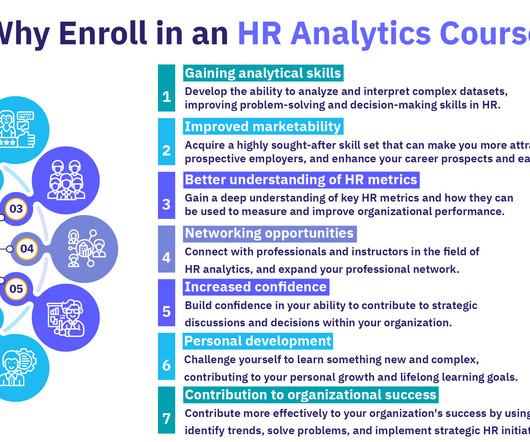
13 HR Analytics Courses Online To Check Out in 2024
FEBRUARY 23, 2024
All subjects are illustrated by real-life examples of how various organizations tap into HR analytics techniques to help them flourish. A dashboard example is included below. It includes facilitated discussions, case studies , group and individual activities, and self-assessments. Want to know more?

9 Digital HR Case Studies with Business Impact
Digital HR Tech
OCTOBER 23, 2019
In this article, we have collected some of the best Digital HR case studies we’ve come across. They’re good examples of organizations that really get Digital HR and make the most of it. Each case study is connected to a specific business imperative. What’s in? Anchor Trust 2. Deloitte 5.

Wal-Mart: Our Fastest Growing Business Line is Delivering Experiences [Case Study]
APRIL 26, 2018
For example , one area in particular that is growing faster than any other part of the business is personal shopping assistance. For example , how should you respond if the customer’s item is out of stock? This set of training examples in itself is highly indicative of the kind of work these people are doing.
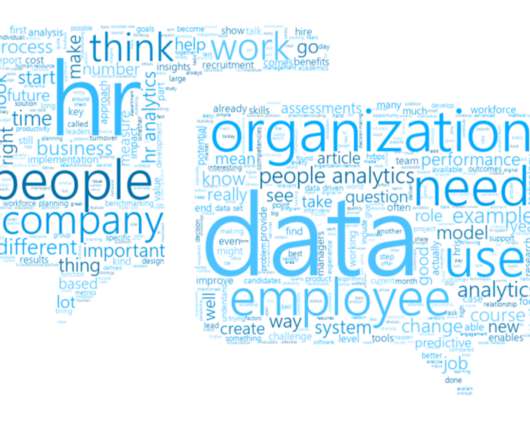
Text Analysis in HR: A Brief Case Study
JANUARY 5, 2020
Take ‘ use’ and ‘ need’ as examples : do they occur often due to a particular focus on what is needed or should be used, or do they typically occur anyway when sharing knowledge through writing? In my opinion, text mining and natural language processing are prime examples of that. Words that are common may not always be important.
Case Study: How One Healthcare Agency Uses Appreciation to Improve Business and Patient Outcomes (#greatness17)
AUGUST 8, 2017
This data is one company’s example of how to do that, but it’s a great script for those of you that are looking to explore the value that appreciation and recognition can bring. Thanks to O.C. Tanner for the invitation to the event and for access to Ms. Ullom-Vucelich for the amazing conversation! Enjoyed this?

Case Study: Steelcase Uses Onboarding Technology for Leadership Development
FEBRUARY 4, 2019
That’s what companies are discovering about onboarding technology and here’s a super interesting example . For a deeper look at the Steelcase program, read the full case study . The post Case Study : Steelcase Uses Onboarding Technology for Leadership Development appeared first on SilkRoad. Unlimited possibilities.
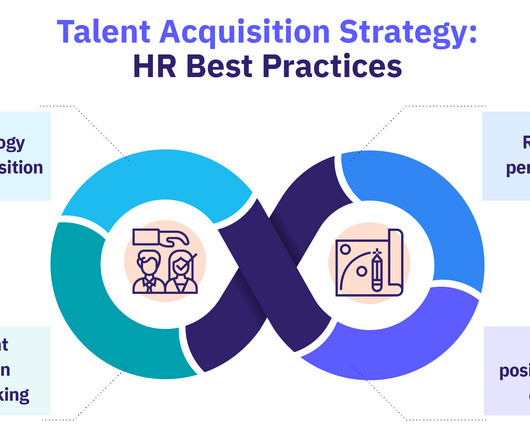
Develop Your Talent Acquisition Strategy With 6 Practical Examples
In this article, we’ll explore what a talent acquisition strategy looks like, how to develop a talent acquisition strategy, along with some best practices and examples to help you move your company forward. Consider, for example , putting together an attractive compensation package with good health benefits (including mental health).

Case Study: Growing Your Marketing Agency With Automated Employee Feedback
MAY 24, 2017
For example , when co-founders Kelsey Meyer & John Hall were leading a team of ten, a weekly in-person meeting was sufficient to surface and address the most important issues facing the business. Influence & Co. , With hierarchy now in place, passing information up the ladder was critical to prevent information bottlenecks.

Why you must start succession management planning now – a case study
Business Management Daily
MAY 7, 2021
Human resources leaders can use this example as a reminder as to why they need to drive succession management conversations frequently and with vigor. The post Why you must start succession management planning now – a case study appeared first on Business Management Daily.
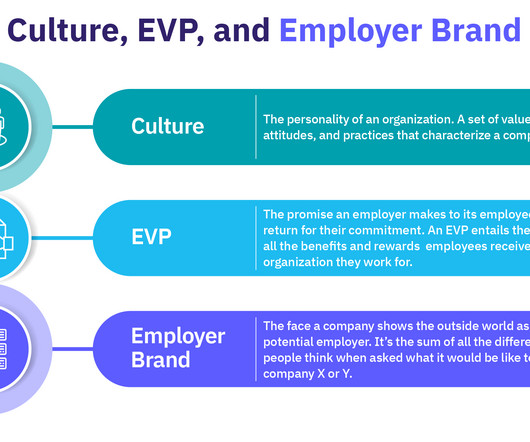
13 Great Employer Branding Examples To Inspire You in 2024
SEPTEMBER 15, 2023
In this article, we’ll share 13 exceptional employer branding examples and what we like about them to inspire you in building your employer branding strategy. Types of employer branding content Employer branding examples 1. Now, let’s dive into the best employer branding examples ! Contents What is employer branding?
Stay Connected
Join 398,000+ Insiders by signing up for our newsletter
- Participate in Human Resources Today
- 2019 Human Resources Today Summer Reading List
- Stay At Home Reading List
- Add a Source
- Add a Resource
- See All
- 2018 Human Resources Today MVP Awards
- 2017 Human Resources Today MVP Awards
- 2019 Human Resources Today MVP Awards
- 2020 Human Resources Today MVP Awards
- 2021 Human Resources Today MVP Awards
- 2022 Human Resources Today MVP Awards
- Tue. Apr 09
- Mon. Apr 08
- Sun. Apr 07
- Sat. Apr 06
- Mar 30 - Apr 05
- Employee Engagement
- Onboarding Software
- Talent Management
- Performance Management
- Time and Attendance
- More Topics

Input your email to sign up, or if you already have an account, log in here!
Enter your email address to reset your password. a temporary password will be e‑mailed to you., be in the know on.
Human Resources Today
Expert insights. Personalized for you.
We organize all of the trending information in your field so you don't have to. Join 398,000+ users and stay up to date on the latest articles your peers are reading.

Get the good stuff
Subscribe to the following Human Resources Today newsletters:
You must accept the Privacy Policy and Terms & Conditions to proceed.

You know about us, now we want to get to know you!
Check your mail, we've sent an email to . please verify that you have received the email..
We have resent the email to
Let's personalize your content
Use social media to find articles.
We can use your profile and the content you share to understand your interests and provide content that is just for you.
Turn this off at any time. Your social media activity always remains private.
Let's get even more personalized
Choose topics that interest you., so, what do you do.
Are you sure you want to cancel your subscriptions?
Cancel my subscriptions
Don't cancel my subscriptions
Changing Country?
Accept terms & conditions.
It looks like you are changing your country/region of residence. In order to receive our emails, you must expressly agree. You can unsubscribe at any time by clicking the unsubscribe link at the bottom of our emails.
You appear to have previously removed your acceptance of the Terms & Conditions.

We noticed that you changed your country/region of residence; congratulations! In order to make this change, you must accept the Aggregage Terms and Conditions and Privacy Policy. Once you've accepted, then you will be able to choose which emails to receive from each site .
You must choose one option
Please choose which emails to receive from each site .
- Update All Sites
- Update Each Site
Please verify your previous choices for all sites
Sites have been updated - click Submit All Changes below to save your changes.

We recognize your account from another site in our network , please click 'Send Email' below to continue with verifying your account and setting a password.
You must accept the Privacy Policy and Terms & Conditions to proceed.
This is not me
- Technical Support
- Find My Rep
You are here
Cases in Human Resource Management
- David Kimball - Elms College
- Description
Cases in Human Resource Management provides students with insights into common challenges, dilemmas, and issues human resource managers face in the workplace. Using a wide variety of well-known companies and organizations, author David Kimball engages students with original, real-world cases that illustrate HRM topics and functions in action. Each case is designed to encourage students to find new solutions to human resource issues and to stimulate class discussion. Case questions challenge students to think critically, apply concepts, and develop their HRM skills. The contents are organized using the same topical coverage and structure as most HRM textbooks, making Kimball the ideal companion for any introductory HRM course.
See what’s new to this edition by selecting the Features tab on this page. Should you need additional information or have questions regarding the HEOA information provided for this title, including what is new to this edition, please email [email protected] . Please include your name, contact information, and the name of the title for which you would like more information. For information on the HEOA, please go to http://ed.gov/policy/highered/leg/hea08/index.html .
For assistance with your order: Please email us at [email protected] or connect with your SAGE representative.
SAGE 2455 Teller Road Thousand Oaks, CA 91320 www.sagepub.com
Supplements
May adopt as a supplementary Text in the future.
KEY FEATURES
- Original case studies bring concepts to life through a number of well-known organizations, including Apple, Amazon, Google, LinkedIn, and Zappos.
- Case questions require students to think critically about HR issues and apply HR concepts to each case.
- An emphasis on important issues and current trends in HRM brings up key topics in the field such as state and federal minimum wage, succession planning, executive compensation, mindfulness, cyber attacks, CSR, and managing a multigenerational workforce.
- A chapter on international HRM topics examines important issues like that of helping expatriates succeed.
Sample Materials & Chapters
Chapter 7: Training, Leading, Talent Management and Development
Chapter 16: Global Issues for Human Resource Managers
For instructors
Select a purchasing option.

This title is also available on SAGE Knowledge , the ultimate social sciences online library. If your library doesn’t have access, ask your librarian to start a trial .
making HR better, one HR pro at a time

13+ HR Case Studies: Recruiting, Learning, Analytics, and More
Reposting a piece from the blog over at Lighthouse Research because I know not all of you subscribe over there!

While much of the work we do at Lighthouse Research & Advisory focuses on quantitative research studies, we do a fair amount of qualitative research as well. We’ve collected case studies over time (and continue to) that highlight interesting approaches and examples of innovation within human capital management. The list below offers a wide variety of industries, examples, and flavors for you to learn from.
Want to see another topic or example not listed here? Comment below and and I will see what we can do to find that for you!
Wal-Mart, Automation, and Compassion Training
Walmart’s Fastest Growing Line of Business is Delivering Experiences
The Motley Fool: Blending Talent Management and Engagement
Motley Fool: The Coolest Talent Processes You’ve Never Heard Of
Chipotle: How Internal Mobility Reduced Turnover by 64%
Internal promotion-how Chipotle reduced turnover by 64%
Adtran: Using Hackathons for Employer Branding, Employee Development, and Retention
Using Hackathons for Branding and Retention
Stout Advisory: Performance Management, Peer Feedback, and Employee Engagement
How to Radically Change Your Performance Management Practice [Podcast]
H&R Block: Seasonal Hiring, Strategic Recruiting, and Hiring Manager Communications
Patagonia: measuring the roi of hr programs, hr strategy, employee perks and benefits.
Measuring the ROI of HR Programs is Critical: Here’s How Patagonia Does It
Hot Chicken Takeover: Employee Benefits, Corporate Culture, Leadership, and Social Responsibility
Can a Business Grow Competitively While Doing Social Good? [Podcast]
AlliedUniversal: Talent Acquisition, Employee Referrals, and High-Volume Hiring
How Does AlliedUniversal Hire 90,000 Workers a Year? Referrals and PURPOSE [Podcast]
Duie Pyle: Remote Worker Engagement, Blue Collar Challenges, and Competitive Recruiting
Talent Lessons from the Transportation Industry [Podcast]
Ohio Living: Core Values, Company Culture, and Employee Recognition
We’re Only Human 39: Ohio Living Serves 70,000 Clients Annually with Core Values
Cox Enterprises: HR Analytics, Business Impact, and Strategy
We’re Only Human 53: How to Partner with Your Talent Analytics Team
McDonald’s: Learning Measurement, Business Impact, and ROI
Southwest airlines: corporate culture, employee perks, and employee engagement.
We’re Only Human 40: How Southwest Airlines Lives and Breathes Corporate Culture
HJF: HR Technology Selection and Implementation, HR Leadership, and Modernization
We’re Only Human 55:The HR Leader’s First Year on the Job
- Book a Speaker
Lorem ipsum dolor sit amet, consectetur adipiscing elit. Vivamus convallis sem tellus, vitae egestas felis vestibule ut.
Error message details.
Reuse Permissions
Request permission to republish or redistribute SHRM content and materials.
Student Workbooks
Welcome to the Student Case Study Resources page. Thank you for reviewing the Terms of Use for Students and clicking on the ‘accept’ button to gain access to case study content available for your exclusive use.
The case study method is a very effective way of helping you think critically to apply the concepts you have learned in your studies at university. There is one Student Workbook for each case. Please click on the content domain headline to see the list of cases for which you may download the Student Workbook.
Compensation and Benefits
Benefits and business at aflac and l. l. bean.
By Sandra M. Reed, SPHR Today, HR professionals are responsible for programs far beyond the profession’s administrative personnel roots. They are expected to measure the success or failure of HR practices based on the achievement of organizational outcomes. Brand identity, bottom-line profitability, employee job satisfaction, and increased management focus are all outcomes that can be achieved, in part, through an organization’s total rewards program. This case examines two very different organizations and how they align their total rewards programs with their organizational goals and values. This case study is of moderate difficulty for an undergraduate audience. A student workbook is available to download.
Designing a Pay Structure: A Case Study and Integrated Exercises
By Lisa A. Burke, Ph.D., SPHR Compensation is a critical area of human resource (HR) management, and one that can greatly affect employee behavior. To be effective, compensation must be perceived by employees as fair, competitive in the market, accurately based, motivating and easy to understand. This case is rated as slightly challenging and requires familiarity with and use of the Internet and Microsoft Excel. Instructors can make the case and associated exercises less challenging by eliminating certain tasks assigned in the case, or may increase the difficulty by adding other relevant tasks and questions. Teaching notes accompany the case. Instructors who have previously taught compensation courses, are familiar with the Internet and Excel, have work experience with pay systems, or who conduct research in compensation area may find the case easier to facilitate. A student workbook is available to download.
Employee and Labor Relations
Classism isn’t classy: exploring socio-economic diversity.
By Rita Rizzo, M.S., CMC This case explores the socioeconomic differences among employees of a family-owned pool and spa contracting and supply store. The enterprise employs 53 workers; 20 skilled workers from the middle class, 30 unskilled workers from the poverty class, and the family of three who owns the store and who come from wealth class. Due to high employee turnover, customer service complaints, scheduling overruns, low morale, and frequent miscommunication, the company owners try to create more synergy and cooperation among the ranks. The case study will take three 50-minute classes to complete and is written for an undergraduate audience.
A student workbook is available to download.
Collective Bargaining in College Dorms
By Patrick P. McHugh, Ph.D. This case promotes learning about the labor relations process in the United States. The case follows the actual efforts of undergraduate resident assistants (RAs) at the University of Massachusetts Amherst (UMass Amherst) who sought to be represented by the United Auto Workers union for collective bargaining purposes. The case highlights:
- The legal parameters regulating labor relations.
- The factors contributing to employee interest in union representation.
- Union election campaign strategies and activities of employers and unions.
- The influence stakeholders have on labor-management relations.
- The importance of pre-contract negotiations.
- The interpretation of the outcome of contract negotiations.
- The important role of contract administration.
The case is designed for undergraduate or graduate students in an introductory or survey HRM course and can be used as a complementary case for an undergraduate or graduate labor relations course.
Under the assumption that the class meets twice a week for 1.5 hours per session, the instructor can cover the entire case in one full class session or divide it into two, covering it in half of two class sessions. Instructors can easily adjust the case for different class time-bands. However, at least 1.5 hours of class time should be allotted for coverage and discussion of the case.
Creating Synergy in a Four-Generation Workplace
By Rita Rizzo, M.S., CMC This case study, written for undergraduate students, is based on generational differences in a metropolitan children’s museum. Employees from various generations experience communication challenges, differing values systems, disparate approaches to work and interpersonal conflict. Learners assume different generation roles and address these issues in a team setting. By the end of the case, learners explore the preferred communication methods and styles to use to be effectively heard and understood in each generation, identify the work ethic characteristics of each generation in today’s workplace, respond to generational differences that affect workplace performance and productivity, and collaborate with others to create and sustain a work environment that capitalizes on generational diversity. This module requires three 50-minute classes to complete.
Fallsburg Schools Negotiations Simulation
By Alan Cabelly, Ph.D. The Fallsburg School Negotiations simulation provides students with the opportunity to negotiate a complex labor agreement in a relatively short period of time. This simulation has been extensively pretested. It has been used by one instructor in approximately 16 different negotiations classes with 300-400 students participating over a span of 10 years. Students have been both undergraduate business students and MBA students; the typical classroom setting has been a 2½-day workshop where the entire focus of the class is negotiation.
The Student Collective Bargaining Act
By Patrick P. McHugh, Ph.D. This exercise explores the labor relations process in the United States, including union organizing, contract negotiations and contract administration. In the United States, the labor relations process is a set of interdependent activities guided by an often confusing regulatory framework, the National Labor Relations Act (NLRA). This exercise will help instructors navigate students through the labor relations process in an effective and engaging way.
Students are given the opportunity to form a fictitious union (the Student Solidarity Union) and engage in collective bargaining with the instructor over the terms and conditions of the final exam. The rules governing the exercise are based on the Student Collective Bargaining Act (SCBA), a fictitious act created to help students understand the NLRA and the labor relations process. It identifies the rights of students and instructors regarding the collective bargaining process over the final exam.
The exercise follows the labor relations process and, as such, is a progressive exercise. The exercise is geared to undergraduate students in an introductory or survey HRM course.
The Vigilance Project—A Case Study on Conflict and Team Dynamics
By Peter G. Dominick, Ph.D. This case provides an opportunity to look at how several different factors interact to affect conflict and team performance. These include contextual issues like a merger, cultural values and physical location. They also include team dynamics and leadership and, last but not least, intrapersonal and interpersonal needs and concerns. Remind students that the case is presented largely from the perspectives of the Americans involved.
Work-Life Balance in Large Organizations
By Gill Maxwell Changing demographics in the U.S. labor force and in other developed countries such as the United Kingdom (U.K.) and recruitment challenges in some organizations have encouraged more employers to consider work-life balance and flexible working arrangements. Developed for an undergraduate audience, this case study series explores flexible working arrangements in five different organizations located in Scotland in the U.K. A student workbook is available to download.
Employment Law
Religious discrimination and racial harassment: what ever happened to marshawn demur.
By Gwendolyn M. Combs, Ph.D. The workplace is becoming more diverse as global operations and immigration becomes more widespread. The management of religious differences and the interface of varying religious beliefs and management practice are profound concerns for many HR professionals. Written for an upper-level undergraduate or graduate audience, this case describes a situation involving an employee’s religious beliefs and the allegations of racial harassment which result.
Aetna: Investing in Diversity
By Wayne Cascio, Ph.D. Raymond Marcos, chief diversity officer at Aetna, is preparing to make a presentation to the company’s board of directors at its mid-December meeting. In a deteriorating economic environment that seems to be global in its reach, the board is looking to cut expenses in any way possible. To do that, it is reviewing every major company business initiative. Diversity is one such initiative, and the board wants to understand the business case for it. It also wants to see a clear plan to measure outcomes, including systems and data. Raymond knows that some of the board members are relatively new, that almost all of them are independent directors from outside the company and that they may not have a deep understanding of the historical roots of Aetna’s diversity efforts or the objectives of those efforts. At the same time, he is eager to showcase the company’s diversity initiatives and their results, both direct and indirect.
Click here to download this case study.
Note: Development of this case was made possible by a grant from the Society for Human Resource Management and the National Academy of Human Resources. All of the characters in the case are fictitious. Information presented was current as of the time the case was written. Any errors are solely the author’s.
Building the Future: HR's Role in Organizational Design
By Steve Weingarden, Ph.D. This case study provides a history and overview of organizational design (OD). Students will use the information in the overview to complete an exercise as a hypothetical organizational design consultant working with a real company of their choice. Students will read about the definition and purpose of organizational design, methods of measurement, six models of organizational structure and two models on how to apply organizational structure principles.
This case is intended for advanced undergraduate students. Students studying human resources (HR) will likely benefit most, but general business students should gain insight from the case, particularly regarding the role of HR in organizational design.
Download the student workbook .
This item may be reproduced free of charge for use in HR classrooms in colleges and universities, in training classrooms in the workplace or in any other learning environment where HR knowledge is taught. For all other uses, requesters are directed to the “Obtain reuse/copying permission” button that appears in the Tools box on this item.
IBM’s Global Talent Management Strategy: The Vision of the Globally Integrated Enterprise
By John W. Boudreau, Ph.D. In early 2003, Randy MacDonald, the senior vice president of human resources for IBM Corporation, was reviewing his recent meeting with Sam Palmisano, the CEO of IBM. Randy had been the chief HR executive at IBM since 2000, joining when Lou Gerstner was in the middle of his tenure as IBM’s CEO. Sam and Randy discussed IBM’s strategic view of the evolution of global markets, IBM’s strategic position as a leader in global transformation and the evolving needs of IBM’s clients. Sam coined the phrase “Globally Integrated Enterprise” (GIE) to describe what he had in mind. He foresaw that IBM’s clients would increasingly be moving toward a GIE and that IBM needed to get ahead of that trend. This had implications for every aspect of IBM, including significant implications for IBM’s supply chain, IT systems, strategy, marketing and services development and deployment. Underlying all of these implications were significant challenges for IBM’s human capital and its approach to human resource management. This three-part case examines the strategic issues and the solutions IBM examined and implemented to meet the changing nature of their business and client needs.
To download this case, click on Part A , Part B , and Part C .
Click here for a biography about the author of this case, John W. Boudreau, Ph.D.
International HRM Case Study—International Assignments
By Fiona Robson, Ph.D. This case, based on a fictional U.K.-based organization, gives learners the opportunity to think about key decisions involved in international assignments and to transfer their knowledge of domestic HR issues to an international context. Students will learn about the main elements and issues related to international assignments; when it is appropriate to use expatriate workers; the skills and knowledge needed by expatriate workers; and how organizations can prepare expatriate managers to succeed in an international assignment.
MacroEnterprises, Inc.—A Case Study in Three Parts
By Julia Storberg-Walker, Ph.D.; Diane Chapman, Ph.D.; and James Bartlett III, Ph.D This case study, written for graduate-level students, takes learners into the real-world of human resource (HR) consulting. Learners assume the role of an HR consultant to help a fictitious organization improve its performance. Three different consulting challenges comprise this case; each challenge can be used individually or be offered as one comprehensive assignment to solve all three segments of the case. Learners will explore how to become a strategic HR partner; develop collaborations with external training providers; and integrate evaluation into standard operating procedures.
Three documents comprise this case: a student workbook , a management/office staff dataset in Excel and a manufacturing staff dataset in Excel. The datasets should be used as indicated in the case study.
PAC Resources, Inc.: A Case Study in HR Practices
By Myrna L. Gusdorf, MBA, SPHR PAC Resources is a fictional organization that experiences many of the difficulties common in today’s business climate. In response to declining sales, PAC Resources must transform itself from a strategy of expansion and high profit to one of cost containment and staff reductions. The case is presented in two parts. Part I lays the groundwork for the case, with discussion of the organization and details of the human resource department. Part II is presented in e-mails from various staff members. The e-mails identify specific problems that need to be addressed by the HR department and give the reader an understanding of PAC’s overall culture.
This case is appropriate for upper-level undergraduate or graduate students in a human resource (HR) management or business management degree program. At a minimum, students should have previously completed lower-division classes in HR management, introduction to business and principles of management.
Power and Influence in the Management of Human Resource Development
By Rick Holden and Vivienne Griggs There is a wealth of literature exploring power and influence in organizations. These cases examine the effect of these issues on the role and effectiveness of human resource development (HRD). The goal is to explore the reality of HRD in organizations and in doing so, highlight tensions that emerge when theory is applied to actual practice. The cases are based on interviews with one or two key people in each organization as part of a wider research project.
Reyes Fitness Centers, Inc.
By John Sherlock, Ph.D. This case describes a growing mid-size U.S. company in the Southeast in the fitness club industry. The recently hired HR director is given the opportunity by the organization’s CEO to propose HR initiatives to help the business meet its strategic goals. The case gives HR students the opportunity to deepen their understanding of strategic HR management. The case is divided into Parts A & B to allow flexibility of covering the case either one part at a time or in its entirety, depending on the content and schedule of a course.
Training and Development
Case study: southwood school—training and development.
By Fiona Robson, Ph.D. This case study, based on a real organization but fictionalized organization in the U.K., explores training and development issues. Students will learn how to identify the components of an effective training program; understand what must be considered when designing a training program; compare the soft and hard skills required by the appraisers and appraisees in this case study; identify the vital role of appraisees in an effective performance management program; and how to effectively evaluate a training program.
Download the student workbook for this case.
Note: Southwood School is a three-part case intended to be taught in succession beginning with Performance Management, then followed by Training and Development then Recruitment and Selection. Instructors have the flexibility to use one, two or three of the cases depending on need.
Developing a Leadership Strategy: The Case of the Toy Research Society
By Steve Weingarden, Ph.D. This case encourages students to consider organizational development needs when creating a leadership development philosophy and an associated leadership development design.
The Toy Research Society (TRS), a nonprofit organization, has been in existence for more than 70 years. The organization's mission has remained the same during this time, but the membership, the use of the Society by nonmembers and the competitive landscape have changed substantially. Driven primarily by a board of directors and regional volunteer leaders, the Society has never had a formal leadership development philosophy. Now, the long-time president has retired, and TRS leaders are reflecting on how to prepare for the future, especially with increased calls for leadership role clarity and more delegation of work to members. As a member, you have the opportunity to develop the needed leadership strategy.
Target Audience: This is a scenario-based case study with an optional exercise. It is intended for upper-level undergraduate students studying organizational development or behavior, leadership development or human resource development. Students in more "generalist" HR courses may find this case too removed from mainstream HR to fit their needs and may find the content too challenging.
K. Hovnanian’s Approach to Preserving Intangible Assets After Acquisitions
By Paula Caligiuri, Ph.D., and William Castellano, Ph.D. This case study examines homebuilder K. Hovnanian’s approach to acquisitions, with a focus on how the organization retains key intangible assets – such as leaders’ knowledge and social capital – of their acquired companies. It introduces learners to the HR and business strategy issues associated with acquisitions. By the end of the case study, students will be able to identify HR’s role in retaining intangible assets during a strategic acquisition; understand the challenges to managing acquisitions when retaining key intangible assets is a strategic goal; develop HR strategies and implementation plans to integrate the intangible assets of both organizations; and address key HR challenges during the post-acquisition phase.
Click here to download the student workbook for this case study.
New Kid on the Block: Diagnosing Organizational Development Issues Using Data
By Steve Weingarden, Ph.D. In this scenario-based case study, undergraduate business or HR majors explore how to diagnose organizational issues, particularly as they apply to talent management and organizational socialization and onboarding. Students will learn how to judge the accuracy of opinions versus data; develop an approach to gather meaningful data; understand the importance of having a strategy to develop a diverse talent pool of qualified candidates; and learn the importance of onboarding and socialization in job satisfaction and retention.
Workforce Planning
Case study: southwood school—performance management.
By Fiona Robson, Ph.D. This case study examines the implementation of a new performance management system designed specifically for support staff at a school in the United Kingdom. This is the first part of a three part case about Southwood Schools and implementation of its new performance management system.
Case Study: Southwood School—Recruitment and Selection
By Fiona Robson, Ph.D. This case study, based on a real but fictionalized organization in the U.K., was developed to provide resources to promote learning and understanding in the areas of recruitment and selection. It is geared toward an undergraduate audience.
Click here to download the student workbook file for this case.
Four Recruitment and Retention Case Scenarios
By Marcia R. Gibson, Ed.D. In this series of four case scenarios on recruitment and retention, undergraduate students are presented with business-based scenarios and are asked to consider the staffing requirements for a new project. Students will learn to determine recruitment needs; identify recruitment policies and guidelines; determine a recruitment strategy and develop a communication plan to implement the new recruitment strategy.
This case includes the case scenarios in a student workbook .
Is There a Doctor in the House? Attracting Physicians for an Underserved Area
By Francine K. Schlosser, Ph.D. This case explores physician attraction issues in a mid-size Canadian city located in Southwestern Ontario, Canada. To address a severe physician shortage, city leaders must create a compelling vision of the benefits incoming doctors might anticipate when opening practices in their area. Students will identify how to improve the current recruitment strategy; develop interview and discussion points for incoming and visiting candidates to ensure a position-person fit; and develop customized recruitment strategies.
The Case of the Writer Who Couldn't Write
By Alan Cabelly, Ph.D. This case focuses on two key organizational issues: Staffing decisions (Case A) and performance management (Case B). Related issues include the relationship between staffing and performance management, managerial control and decision making, termination decisions and the role of an established group in new employee socialization. Instructors can focus on staffing, performance management or both.
The case is based on a real case; students will be intrigued to find out what happened in the actual situation. It can be analyzed by using a traditional Harvard style analysis, by having students develop staffing and coaching techniques or through the use of role plays. These methods can be combined.
This case can be adapted for use by undergraduate or graduate students in either an advanced organizational behavior course or any level human resource management course.
Top Choice—A Case Study in Succession Management
By Steve Weingarden, Ph.D. This is a scenario-based case study with a structured exercise available. It is intended for upper-level undergraduate students, preferably with a basic understanding of organizational structure and selection. Upper-level undergraduate students will engage in a case study about succession planning management—specifically at the executive level in a highly public situation—and job analysis.
Workforce Planning: Aging and Employment
By Barbara McIntosh, Ph.D., SPHR Shifting demographics, the changing nature of work and the emerging platforms to achieve productivity, including technology and workplace flexibility, are increasing the need for strategic human resource (HR) management and planning. Understanding the issues related to an aging workforce is central in this planning process. Economic conditions, uncertainty in the labor market, and intergenerational dynamics are changing both employer and employee expectations about the role of work, and the impact of these volatile forces on employment remains uncertain. The issues are particularly complex because of the regulatory and legal environment, productivity demands, and established HR policies and practices. This course examines labor market dynamics, labor force participation patterns, evolving employer policies and practices, and changing employee expectations. Particular emphasis is placed on current best practices and emerging trends regarding older workers.
Two case studies are included as part of this course. Click on each link below to access the desired document:
Gardens for All Supply Company: Older Workers as a Tactical Advantage for Business Student workbook
General Appliances: An Aging Workforce Case Study Student workbook
The development of these case studies was made possible through the support from a grant from the Alfred P. Sloan Foundation.
Multiple Content Areas
Central columbia hospital.
By Steve Riccio, Ed.D., SPHR Competencies: Relationship Management; Communication
Central Columbia Hospital was founded in 1889 as a nonprofit, community based health care facility in northeastern Pennsylvania. This 116-bed, acute care facility employs 963 employees and is nestled along the Susquehanna River’s northern branch in Briar Creek. The facility provides general medical and surgical services to the surrounding community of approximately 70,000 people. The hospital is proud of its tradition of upholding its mission to these communities by providing comprehensive health care services in a compassionate, caring and cost-effective manner while maintaining the highest level of professional excellence. The hospital is in the process of a yearlong celebration commemorating its 125th anniversary. They are experiencing a fair number of interesting HR issues presented in five individual cases.
On this site, the student workbooks are available for students to download.
Each scenario includes question sets for undergraduate and graduate students. Your instructor may assign additional questions as well. The scenarios are as follows:
- Scenario A: Transactional to Transformational HR.
- Scenario B: Retention.
- Scenario C: Talent Development.
- Scenario D: Technology/Social Media/HIPAA.
- Scenario E: Acquisition and Organizational Culture/HR Communications.
Hudson College
By Steve Riccio, Ed.D., SPHR This case study was used for the case solving competitions held at five regional student conferences in March and April of 2014.
The case involves a fictional organization.
Founded in 1881, Hudson College is a private liberal arts institution located in Beacon, New York. Hudson is a four-year undergraduate institution accredited through the Middle States Association of Colleges and Schools. One of its strengths is its strong partnership with the vibrant Beacon community. Hudson has been challenged by the difficult economic climate, increased competition among schools within and outside its peer group, and external pressure from its key stakeholders. The college's current strategic plan outlined an ambitious agenda focused on diversity and inclusion, a reenergized commitment to increasing the school's affinity among its alumni, and a multiyear capital project initiative that includes new construction and renovations to support the academic and residential experiences for students. Some faculty and administrative staff believe recent retirements and resignations of individuals in key positions have affected employee morale and the college's reputation of providing outstanding service to its students.
The case begins with introductory information about the organization and is then divided into five scenarios. Each scenario includes question sets for undergraduate and graduate students. Debriefs are included with each scenario.
Click on any of the following to download the desired scenario:
- Scenario A: Talent management | Student workbook
- Scenario B: Employee engagement | Student workbook
- Scenario C: Performance management | Student workbook
- Scenario D: Title IX | Student workbook
- Scenario E: Employee benefits | Student workbook
The Georges Hotel: A Case Study
By Myrna L. Gusdorf, MBA, SPHR This case study was used for the case solving competitions held at five regional student conferences in March and April of 2013.
The Georges Hotel is a small upscale boutique hotel located along the Magnificent Mile in Chicago. It is owned by two brothers, Jeff and Chad Mitchell. The Georges was rebuilt from an old hotel that was badly in need of repair when the Mitchells purchased it from a major hotel chain in 1995. After extensive renovation, the property was reopened as the Georges Hotel and has operated profitably since 1998. As the case opens, the Mitchells are preparing to acquire another run-down hotel in Chicago. It too will be renovated and reopened. This will be the second Georges Hotel in what they anticipate will be a small chain of Georges Hotels located in major cities across the country.
Click any of the following to download the desired scenario:
- Scenario A: Family-owned business and strategic planning | Student workbook
- Scenario B: Succession planning | Student workbook
- Scenario C: Staffing and employee conduct | Student workbook
- Scenario D: Supervisors and equal employment opportunity | Student workbook
- Scenario E: Supporting the organization's mission | Student workbook
Return to Student Member Center
Related Content

Rising Demand for Workforce AI Skills Leads to Calls for Upskilling
As artificial intelligence technology continues to develop, the demand for workers with the ability to work alongside and manage AI systems will increase. This means that workers who are not able to adapt and learn these new skills will be left behind in the job market.

Employers Want New Grads with AI Experience, Knowledge
A vast majority of U.S. professionals say students entering the workforce should have experience using AI and be prepared to use it in the workplace, and they expect higher education to play a critical role in that preparation.
Advertisement

Artificial Intelligence in the Workplace
An organization run by AI is not a futuristic concept. Such technology is already a part of many workplaces and will continue to shape the labor market and HR. Here's how employers and employees can successfully manage generative AI and other AI-powered systems.
HR Daily Newsletter
New, trends and analysis, as well as breaking news alerts, to help HR professionals do their jobs better each business day.
Success title
Success caption
- Browse All Articles
- Newsletter Sign-Up
HumanResources →
No results found in working knowledge.
- Were any results found in one of the other content buckets on the left?
- Try removing some search filters.
- Use different search filters.
- philippines

Best practices: 10 most popular case studies of 2019
- main#clickShareSocial">email
- main#clickShareSocial">telegram
- main#clickShareSocial">whatsapp
- main#clickShareSocial">wechat
- main#clickShareSocial">pinterest
- main#clickShareSocial">line
- main#clickShareSocial">snapchat
- main#clickShareSocial">reddit
A compressed workweek that drove employee engagement, an "unbossed" leadership approach to employer branding, and the use of robotics to save nine man days -we've heard about it all this year.
To recap, this special edition of the HR Bulletin showcases 10 of our most popular case studies of 2019, featuring the tried-and-test best practices of Experian, Shopee, BAT Singapore, and more.
1. How foodpanda is overcoming the matter of people working "systematically long hours"

As part of a special feature we did this year on work-life harmony, hear from Managing Director Luc Andreani , a line manager, and a Millennial on what integrating work and life really means, and how foodpanda's flexible working initiatives focus on the quality of work produced, over the number of hours clocked in.
[ Read the full case study here ]
2. How an "unbossed" leadership approach drives Novartis' employer branding journey

In this exclusive , Jason Tan, Head of HR for People and Organisation, Novartis , sheds light on the firm's "unbossed" philosophy, and how this approach to employer branding led to a series of D&I and CSR initiatives for the greater good.
3. How British American Tobacco Singapore reduced absenteeism by 23%

Rather than focusing on fixed targets, BAT creates a culture where employees are empowered to make conscious choices towards their health, Mausami Arora, Head of HR, British American Tobacco Singapore , shares.
4. How Shopee has trained over 450 leaders across the region for a learning culture

Lim Teck Yong, Shopee's Head of Regional Operations and People Team , speaks on the online marketplace's competency-based, systematic and holistic approach towards leadership development for both new and experienced leaders.
[Read the full case study here]
5. How AXA Affin GI's compressed workweek drives high employee engagement

Anuradha Purbey, People Function Director for Southeast Asia, Aviva , is tapping on technology to create capacity for accelerating business growth . Here's how the team got started on this journey.
Interviewees' photos / providedLead image / xxStock photo / iStock
Follow us on Telegram and on Instagram @humanresourcesonline for all the latest HR and manpower news from around the region!
Related topics
- Talent Management

Free newsletter
Get the daily lowdown on Asia's top Human Resources stories.
We break down the big and messy topics of the day so you're updated on the most important developments in Asia's Human Resources development – for free.
5 Ideas for Human Resources Case Studies
- Published May 31, 2018
- Last Updated April 8, 2022
Find Your Degree!
Ideas for Case Studies in the Human Resource Field
- Work-Life Balance in Large Organizations
- Exploring Socio-Economic Diversity
- Student Collective Bargaining Act
- Integrated Exercises for Designing a Pay Structure
- Conflict and Team Dynamics
Human Resource Management is a huge field that impacts several different areas of business and even other personal aspects of employees. Professionals and managers within the field must tackle issues with compensation, benefits, employee & labor relations, employment law, training, employee development, workforce planning, and in today’s modern climate, strategy.
Since the field is all-encompassing, it’s never been more crucial for future human resource managers to study for a graduate degree. Part of the curriculum requirement in most respected HRM programs will be to complete a case study. Students are expected to take an in-depth look at a subject of study and analyze the data gathered to support their thesis. Coming up with Human Resources case studies can be challenging.
Ranking: 50 Most Affordable Small Colleges for an HR Degree
1 – Work-Life Balance in Large Organizations
The American culture is centered around hard work. While this is a positive motivation in some cultures, the lack of work-life balance can be frowned upon in others. The focus of the Work-Life Balance in Large Organizations case study is to analyze how the changing demographics in the country, along with challenges that recruiters have finding candidates, have created a greater need for larger companies to offer more flexible arrangements as a benefit.
2 – Exploring Socio-Economic Diversity
Strategic planning in HR is important when it comes to the labor force. This case study involves exploring how socioeconomic status affects employee turnover, scheduling, employee morale, customer complaints, and interdepartmental communications. The goal of this Human Resource case study is to see how to create synergy in a company made up of wealthy, middle-class and poverty-level employees.
3 – Student Collective Bargaining Act
Labor laws and constant updates in protections for employees and college students can affect the operations of the HR department as a whole. The purpose of this case study is for students to review the regulation set forth under the National Labor Relations Act to explore the labor relations process. Students will form their own union, negotiate contracts, administer contracts, and protect rights of the students in their union over the course of the study.
4 – Integrated Exercises for Designing a Pay Structure
Pay structure is extremely important to employees. In fact, it’s one of the top priorities on every worker’s list. This is why HRM students who want to work in management can benefit from completing a case student on designing a pay structure that is fair, easy to comprehend, motivating, and competitive. Research of compensation in the area and pay systems used in the field will be necessary to complete the study.
5 – Conflict and Team Dynamics
Conflict is present in every organization as employees with different personalities are all expected to interact with one another. A team’s performance can dramatically suffer when conflict is present. It’s important for HR managers to understand what factors contribute to conflict. This case study looks at how location, mergers, cultural values, personal beliefs, and intrapersonal needs can all affect perspectives and interactions.
There are plenty of great ideas for case studies available through the Society for Human Resource Management. These ideas all pertain to a different area of HRM in which students may want to specialize. Review the Human Resources case studies above and decide which one sounds most interesting.
Related Resource: What is Workforce Diversity?
Phone Login
Looks like you already have an account with this ID. You can try logging in
Forgot password?
Back to login
Register Now
This Email id already exist please try loging in
Create an account to find courses best suited to your profile
- September 26, 2022
Best HR Case Studies
Drop your details to know more about programme
- Mobile Number *
- State * State* Andaman and Nicobar Andhra Pradesh Arunachal Pradesh Assam Bihar Chandigarh Chhattisgarh Dadra and Nagar Haveli Daman and Diu Delhi Goa Gujarat Haryana Himachal Pradesh Jammu and Kashmir Srinagar Jharkhand Karnataka Kerala Lakshadweep Madhya Pradesh Maharashtra Manipur Meghalaya Mizoram Nagaland Odisha Puducherry Punjab Rajasthan Sikkim Tamil Nadu Telangana Tripura Uttar Pradesh Uttarakhand West Bengal
- I accept Terms and Conditions
Last date of application: 14/07/2022
HR as a function has undeniable importance from a business management perspective. With the advancement in technology, 2022 saw a huge technological shift in this aspect of business management as well. Apart from digitizing all other business aspects, organizations have begun to incorporate technology and data into HR practices as well.
HR Analytics Case Studies with Business Impact and its benefits are listed below:
An american mnc reduces attrition using people analytics and forecasting.
Case: This American MNC is a client of PeopleStrong and is suffering from a high turnover of employees at five locations. The company intended to install analytics in order to evaluate the main drivers of attrition and do forecasting for their occurrence at different business locations.
Solution: An integrated tool for workforce analytics was created and implemented. This tool could capture attrition results and their drivers and do a forecasting based on trends.
Also Read: Executive Development Program In Human Resource Management From XLRI Jamshedpur
Result: The forecasting report predicted that 500 of the 5000 employees were going to quit in the next 6 months. Better employee retention policies were designed which included rewards and incentives apart from better people strategies. Even though 250 people still left, the figure was 50% lower than the prediction.
Under Armour digitized employee recruitment and enhanced employee experience
Case: Under Armour, an American organization dealing with the manufacture of sports and casual apparel and footwear, is a global company. With more than 130 global outlets and 8500 employees, their ATS system received more than 30,000 resumes in a month. Thus, hiring was a cumbersome process for them as well as candidates applying for a job.
Solution: They engaged in a digital recruitment system called Hirevue. With Hirevue, managers could create interviews with candidates with the help of pre-recorded questions. This screening process helped managers call in only employees who met their requirements for webcam or mobile recorded interviews.
Result: Managers could now hire new employees much more quickly. There was a 35% reduction in time in the overall interview to the hiring process. Talent quality also improved.
These above case studies show the emerging trend of incorporating analytics in the HR function of business management . This can also be seen to have positive results in the recruitment and retention processes.
Human resource management is quite a recent term. Employees are treated with a lot of respect and regard nowadays compared to earlier. There were times when workers were considered to be expendable and they had few rights. Working conditions were miserable and people had no say in how organizations are operated or in the way they were treated. The industrial revolution is what brought changes. Companies started realizing that keeping employees loyal was essential for running businesses smoothly.
Caring For Employees During The Industrial Revolution
Courses for human resources certification online teach that before the industrial revolution there were hardly any large industries and a need for managing workers was not felt. Working conditions were dangerous for them and pay was hardly commensurate with what work they did. In the late 1900s, companies like the UK-based Cadbury and Jacob from Ireland appointed welfare officers. These firms introduced a system of payment during sick leaves and cheap housing for employees.
Also Read: Executive Development Program In HR Analytics From XLRI
It was F W Taylor during the early twentieth century who introduced a system for managing staff. He believed that people could be trained to become experts in certain jobs. The famous carmaker Ford adopted his methods. Tools in manpower management like job analysis, employee selection procedures, and training methods were introduced during this period. Certain fast food organizations also adopted Taylor’s theories. His mistake was that he did not think people can get bored with doing the same job.
Employee Management During The World Wars
Two events that changed many things for us are the first and second world wars. Employee unions had been formed during the first world war. As men went to fight wars, women came to be seen more in workplaces. In your HR training certification by IIM Raipur , you will learn how companies had to think about managing workers and form new rules. Recruitment, dismissal, bonus, and absence from work came under the scope of manpower management.
Researchers like Elton May opined that factors like motivation, job satisfaction, leadership skills, and group dynamics could influence performance. The improvement in the economy after the war saw many firms adopting a more flexible approach to staff members. Big companies used employee benefits to lure and retain people. Personnel and welfare work was in full swing during the second world war, but it was done in a bureaucratic style as government-run firms influenced law-making.
The Post-War Scenario
The 60s were not good times for industrial relations as it was found that none of the entities involved in negotiation had skills to discuss issues of employees. As the decade came to an end, employment opportunities improved, and along with this, people management techniques began to be used. When you study human resources certification online courses you will know that terms like motivation, organizational behavior, and management training were heard more commonly.
Also Read: Executive Development Program In Talent Management
In the seventies, much was talked about rewarding employees. The next two decades saw economies sliding and companies becoming less profitable. But it was also then that many organizations realized the importance of retaining people. They began looking at workers as an asset that must be taken care of if the firm wants to have an edge over competitors. Humans started to be regarded as resources that need to be effectively managed. Human Resource Management was born.
The Nineties To Now
It is no more only personnel management and administrative tasks for workforce heads. The HR training certification by IIM Raipur will tell you that it is more about employee engagement and development that people managers are tasked with now. Human resource departments are strengthening the culture in an organization and finding people who can fit that environment. They are also tasked with ensuring that every employee gets an opportunity to use his or her talents for the benefit of their companies.
Also Read: Why is it Important to Study Human Resource Management?
HR managers are more focused on workers than on processes. This department is also gaining more importance as management’s realize a need to attract and retain the best talents available in the market. HR leaders find themselves among the C-suite as their role in getting the best out of employees is increasing. They must understand the needs of a more diverse, multicultural, and multigenerational workforce and ensure to fulfill them. Retention of good hands has assumed much importance nowadays.
The Future Of HR Management
The human resources certification online courses will teach that it is not just enough to employ and retain people, but they must also be trained and developed. The speed at which new technologies emerge, there is a need to keep employees abreast of modern developments. HR managers must continuously update themselves with modern technology and arrange training programs to empower workers with new skills. The journey of staff members in an enterprise will be that of continuous learning.
Acquiring best talents and retaining them will remain the focus of any progressive organization. People managers will have to find innovative means to attract those who are equipped with the latest skills required for a job. Engaging with prospective employees through social media platforms will be practiced by more HR heads. There will be increased use of automation for screening resumes and conducting initial interviews. This will speed up the process and reduce costs.
HR departments will be trying innovative methods to improve employee experience in the company. They will find out the requirements of the new breed of recruits. Learning opportunities will be improved. Promotions and salary hikes will no longer be based on experience or seniority. New procedures for evaluating employees will be used. Getting HR training certification by IIM Raipur will teach new methods that are used by global enterprises for appraisal and rewarding.
Looking at the evolution of human resource management can show you that there has been a shift from looking at employees as only a means to achieve company objectives, treating them as individuals, and satisfying their needs. There is a realization that it is equally important to ensure that their goals are achieved and these objectives are in line with that of the organization. HR departments will play a more important role as retaining good talent becomes crucial. Combining the human force with machines and using that synergy will be highly important in the future.
More Information:
Executive Program In Business Management
Professional Certificate Program In General Management
How to grow your career in Human Resource Management?
Executive Program In Supply Chain Management During Uncertain Times
Professional Certificate Program In Supply Chain Strategy And Management
Executive Development Program In Project Management For Senior Professionals
Want to know how can this course help in your profile?
Talk to our counsellors to find a course best for your career.
- Will get in touch with you soon
Let us call you back
We'll contact you asap.
- Select a Course Select a course Post Graduate Diploma In Finance Doctor Of Business Administration Doctorate of Business Administration Certificate Program in Applied Data Science and Deep Learning Executive Development Programme in Leadership in Sales & Marketing – The CMO Programme Postgraduate Certificate In Business Analytics B- 6 New Digital Marketing Job Linked Bootcamp Executive Development Programme in Strategic Decision Making in the Digital Era Professional Certificate Program in Health Care Management with immersion Advanced Certificate in Digital Marketing and Communication S4 Advanced Certificate in Digital Marketing and Communication S3 Advanced Certificate in Digital Marketing and Communication S2 Executive Development Programme in Applied Finance Executive Development Programme in Talent Management Executive Certificate Program in HR Analytics Advanced Certificate in Supply Chain Management MBA from Staffordshire Business School Professional Certificate program in Cyber Security Doctor of Business Administration in Emerging Technologies Executive Development Program in HR Analytics from XLRI B6 Executive Development Programme in Digital HR Transformation & AI-Driven HR Analytics MICA-MBMC-14-1223 Professional Certificate Program in Business Analytics B8 Professional Certificate Program In Marketing And Sales Management Executive Development Program in Advanced Financial Management MS in Full Stack Artificial Intelligence and Machine Learning MS in Full Stack Artificial Intelligence and Machine Learning MS in Full Stack Artificial Intelligence and Machine Learning Advanced Program in Strategic Management for Business Excellence -B4 Executive Certificate Program in Supply Chain Management and Analytics Master of Business Administration (MBA) Liverpool Business School -immersion MBA (Global) | Deakin Business School- With immersion Executive Development Program in Human Resource Management from XLRI Jamshedpur -B15(Copy) Advanced Certificate in Sales Forecasting and Demand Planning EXECUTIVE DEVELOPMENT PROGRAMME IN DIGITAL TRANSFORMATION STRATEGIES Executive Development Program in Human Resource Management from XLRI Jamshedpur -B15 Executive Development Program in Financial Analytics B-6 Full Stack Development Bootcamp Professional Certificate Program in Health Care Management Executive Development Program in Talent Management from XLRI- B12 Executive Certificate Programme in Advanced Strategic Management & Innovation Executive Development Programme in Driving Growth – The CXO Programme B-2 Executive Development Program in Project Management For Senior Professionals from XLRI Jamshedpur -B10 Ecommerce Supply Chain Management and Analytics Professional Certificate Program in General Management Batch 6 Master of Science in Computer Science Master of Science in Data Science Executive Post Graduate Programme in Machine Learning & AI Executive Development Programme in Strategic Marketing Management (Batch 2) Advanced Certificate Programme in Big Data Programming Advanced Certificate Program in Devops Advanced Certificate Programme in Cloud Backend Development Advanced Certificate Programme in Blockchain Executive Development Programme in Strategic Brand Management -B2 Advanced Certificate Programme in Cyber Security Executive Program in Supply Chain Management During Uncertain Times -B3 Executive Program in Marketing Strategy -B4 Executive Post Graduate Program in Full Stack Software Development Post Graduate Diploma in Management Post Graduate Certificate in Product Management Leadership and Management in New Age Business Executive Development Program in Data Science using Python, R & Excel B-10 Postgraduate Certificate In Business Analytics B- 6 Postgraduate Certificate in Human Capital Leadership -B-2 Executive Development Program in Digital Marketing B-7 100% Job-Guarantee Post Graduate Certificate in Software Engineering Full Stack Development Bootcamp - 100% job opportunities in MAANG/Top product companies Advanced General Management Program Professional Certificate Programme in HR Management and Analytics Executive Post Graduate Programme in Data Science Executive Post-Graduate Programme in Human Resource Management Professional Certificate Program in Data Science and Business Analytics Executive Post Graduate Program in Data Science and Machine Learning PROFESSIONAL CERTIFICATE PROGRAM IN MARKETING AND SALES MANAGEMENT -BATCH 8 Advanced Program in Leadership in the Digital Era -b3 Executive Development Program in Transformational Leadership -B5 Executive Program in Business Management - Batch 3 Professional Certificate Program in Business Analytics from IIM Kozhikode -B7 Executive Development Program in Strategic Management from XLRI -Batch6 Executive Development Programme In Business Analytics and Big Data Executive Certificate Program in Business Analytics and Big Data Advanced Certificate in Managing Brands and Marketing Communication -B-13 Executive Development Program in Human Resource Management from XLRI Jamshedpur -B14 Executive Development Program in Leadership & Change Management b-9 Certificate Programme In Operations Management And Analytics Professional Certificate Program in Supply Chain Strategy and Management - B5 Executive Development Program in Advanced Financial Management Executive Certificate Program in Applied Financial Risk Management -batch-3 Advanced Certificate in Digital Marketing and Communication Global Doctor of Business Administration Executive Development Programme in Strategic Marketing Management (Batch 1) Executive Development Program in HR Analytics -Batch 5 Executive Development Programme in Strategic Brand Management Master of Business Administration (MBA) Liverpool Business School Professional Certificate Program in Business Analytics from IIM Kozhikode Advanced Program in Strategic Management for Business Excellence Executive Development Program in Financial Analytics Advanced Certificate in Advertising Management and Public Relations Executive Development Programme Digital HR Transformation & AI-Driven HR Analytics Executive Program in Business Management Executive Program in Supply Chain Management During Uncertain Times CERTIFICATE PROGRAMME IN STARTUP BOOT CAMP Professional Certificate Program in Supply Chain Strategy and Management CERTIFICATE PROGRAMME IN INDUSTRIAL DESIGN, INNOVATION AND ENTREPRENEURSHIP Executive Development Program in HR Analytics B4 Executive Program in Marketing Strategy
Call us to get more information
Our counsellors will call you back in next 24 hours to help you with courses best suited for your career
- Human Capital Leadership XLRI Jamshedpur
*I hereby authorize Talentedge to contact me. It will override my registry on the NCPR.
Fee Structure
Program Fees
INR /- +GST
EMI Partners
No Cost EMI - 9 Months
Standard emi - 12 months, standard emi - 18 months, standard emi - 24 months.
* I accept Privacy Policy and Terms & Conditions. I appoint MyMoneyMantra as authorized representative to receive my credit information from Experian for the purpose of providing access to credit & targeted offers ('End Use Purpose') as defined in given Terms & Conditions.
* Loan Processing fee to be paid directly to the Loan Provider.
Request a call back
Let us help you guide towards your career path
- Non-biased career guidance
- Counselling based on your skills and preference
- No repetitive calls, only as per convenience

- Request new password
- Create a new account
An Introduction to Human Resource Management
Student resources, case studies.
Case studies exploring fascinating additional case studies from the author demonstrating HRM in practice around the world. From the internal vs. external candidate debate to employer branding abroad, learn how companies of all sizes approach different aspects of HRM.
- Changes in HRD at Hansen Group
The Hansen Group is one of the UK’s largest construction groups. Traditionally, the company has been involved primarily in civil engineering but it has recently begun to diversify, partly through acquiring local government contracts, for example for street maintenance and cleaning and the facilities management of publicly owned buildings, such as universities. Therefore, the company is now involved in a wide range of diverse activities and employs an increasingly diverse workforce, from street cleaners to highly qualified civil engineers.
The three years since the Credit Crunch of 2008 have been incredibly difficult for the construction industry in the UK. As a result of the economic downturn, many construction firms have decreased their spending on learning and development. Hansen Construction has, however, increased its investment in these activities, notably introducing a new apprenticeship scheme for construction team leaders , expanding online learning provision and continuing to recruit and develop significant numbers of graduates. Hansen recognises that talented individuals are the lifeblood of the firm and, therefore, sees investment in workforce development as a key dimension of its employment proposition. This approach is felt to be in line with its commitment to sustainability in its corporate activity.
The learning and development team at Hansen drives learning and development innovations, provides analysis of business learning requirements and manages the delivery of cost-effective learning solutions to support the achievement of business goals. Learning solutions at Hansen include traditional off-the-job classroom programmes, short courses, online learning interventions, workbooks and mentoring. The firm has recently recruited two new team members specifically to design in-house e-learning solutions, and to upgrade the company’s online learning management system.
As well as the learning and development team located at the company’s headquarters, Hansen employs a further 12 learning and development professionals who are located throughout the country and work directly with particular business units and clients, many of whom have diverse needs in respect of employee development.
Traditionally, training needs for Hansen staff have been identified centrally and on the basis of the employee group. This has been consistent with its traditional approach to training for large groups in classroom settings. However, with an increasingly diverse workforce, the company has sought to introduce a new performance management system that focuses on individual performance and the competencies behind that performance.
In 2010, the L&D team sought to supplement its traditional classroom-based training programmes with a series of bite-sized (typically half an hour) interactive learning modules for construction site staff that were linked together to form part of a meaningful programme of activities. These were known as ‘toolbox talks’, and were delivered by site managers, using materials developed to support them by the central team. The talks are mainly devoted to site management and health and safety issues. In addition, a significant part of Hansen’s revised approach to learning and development is to increase the amount of on-the-job coaching employees receive and to create a coaching culture within its management community.
Hansen has made significant investment in technology-based learning (or e-learning), particularly software that enables e-learning specialists within the learning and development team to produce online training programmes, several of which are compulsory for all employees. The learning and development team is exploring other technological solutions, such as the use of mobile phones and DVDs, to deliver learning to its maintenance workers, street cleaners and other employees who do not have ready access to the Internet.
Historically, the evaluation of learning and development interventions at Hansen has tended to focus on the initial reactions of employees by asking them to complete evaluation forms after having attended a training programme. However, as part of the wider changes to learning and development at the company, longer-term evaluation of interventions is now in place. This involves the learning and development centre asking the manager sponsoring any new programme to define what a positive outcome would look like in order to determine an appropriate metric for assessment, such as employee engagement or productivity, and involves contacting recipients of training 3–6 months after they have completed a programme and asking them whether they are doing anything differently as a result of what they have learned.
- Why do you think that Hansen Construction has increased its investment in learning and development activities despite the tough economic climate?
- What are the likely benefits associated with the introduction of an individualised performance management system, and an associated competency framework, to inform learning and development at Hansen?
- What are likely to be the benefits of introducing the ‘bite-size’ training programme delivered by site managers, a renewed focus on coaching and substantial investment in e-learning at Hansen?
- Explain why you think Hansen has decided to change the way it evaluates learning and development interventions.
- Learning and Development at Choc Co.
Choc Co. is one of the world's largest confectionery businesses with significant market share in many of the world's biggest confectionery markets, including many emerging markets. It has a long and proud tradition, stretching back more than 150 years, including a long history of developing its employees, which has remained part of its ethos during its progress to becoming a global company.
Despite very positive sales figures over the last 12months, Choc Co. has prioritised streamlining the business to make it more competitive and has placed a strong emphasis on reducing cost over the next 18 months. Despite being keen to preserve its longstanding reputation as a firm that is committed to developing all its employees, in respect of learning and development, this ‘streamlining’ activity has focused on:
- ensuring a clear return on investment in training activities
- changing the way that learning programmes are delivered and being more creative in developing approaches to learning
- connecting training activities to the strategic needs of the firm.
The most important driver of the assessment of its training provision at Choc Co. is change. Whilst performing well in the marketplace, senior management continue to express discontent with levels of productivity and employee performance. Moreover, senior management has determined that the company needs to become more flexible and adaptable to respond to change in its market context, for example by an ability to adapt organisational structures to meet new business needs or through the introduction of technological innovation. However, as a traditionally minded employer, and with low levels of employee turnover at shopfloor level, Choc co. appears to have instilled in its workers a mindset of stability and steady progress, which is at odds with competition in a rapidly changing global economy. Therefore, Choc Co. wants to move towards a system of continuous improvement by creating a culture whereby workers are empowered to implement small incremental changes, rather than have substantial change imposed on them from time to time.
Identifying training needs
Traditionally, training needs analysis at Choc Co. has been ‘gap-led’. In other words, training tends to be focused where Choc Co. identifies a gap in capability – for example, where the introduction of new technology requires worker skill to be updated, company policy is changed or a key worker leaves the firm, requiring training to be provided to their replacement. Typically this gap-led identification of need is conducted at a local level, with little reference made to the wider national or international workforce.
Whilst workers can put themselves forward for training courses, including those provided by local education providers, there is no formal channel for doing this and access to such training often comes down to personal relationships and the constraints imposed by departmental budgets. The culture at Choc Co. is very much one in which training needs are typically identified for workers rather than by workers.
Delivery of training
Currently, the company runs a number of large training events each year designed to update manufacturing staff on everything from health and safety changes, business strategy and company performance to the adoption of new production technology. This is sometimes coupled with skills training for these workers as and when appropriate. This has traditionally been done at the specialist training centre at their largest production facility, which doubles as the company’s headquarters. This practice partly stems from a time when the company only operated two production facilities in the country. It now operates across six geographically dispersed locations. Workers tend to view these training events as a bit of a waste of time, particularly when they are delivered by consultants with little real understanding of working processes at Choc Co. It is not unknown for workers to claim that the training they receive is outdated and tells them nothing that they don’t already know.
The head of training and development, responding to a call to cut costs from the HR director, is now of the opinion, however, that such long training programmes, often of up to three or four days, are no longer the most cost-effective and efficient means by which to develop the staff. Such training has the dual problem of requiring regular investment and repeat sessions to cover workers on different shifts or at different plants, as well as leading to undesirable downtime of certain aspects of production. In particular, the head of L&D is keen to reduce a reliance on external training providers to design and deliver interventions to different workforce groups, from senior management to shopfloor workers.
Moreover, the company has historically not evaluated the impact of these events. In the new era of cost-cutting and added value, however, the company is keen to ensure that the impact of all training interventions, however big or small, is measured.
Employee development programmes
A major investment in L&D at Choc Co. is in its manufacturing apprenticeship scheme and graduate development programme, both of which are widely viewed as models of good practice in the industry and beyond. These programmes are, however, under significant scrutiny by senior management to better understand the extent to which this investment provides value to the firm. One particular area under review is the turnover of employees who complete these programmes and then leave to work at other firms.
Ray Barbie, the head of learning and development at Choc Co. recently attended a seminar at a local university on ‘the changing nature of workplace HRD’. He was slightly alarmed to find out that much of the company’s practice was seen as outdated. In particular, he was interested in examining how some more contemporary approaches and techniques in HRD could help the company both reduce costs and better performance through continuous improvement.
- What changes would you recommend that Choc Co. make to their current learning and development provision in order to reduce costs and improve performance?
- Discuss how e-learning, competency frameworks and improved knowledge-sharing at Choc Co. might help to cut costs and make the HRD activity at Choc Co. more strategic.
- How might the firm seek to ensure a return on investment for its learning and development activity?
- Developing a Learning Strategy at Wellread Books
Wellread Books is a high street retailer established in 1993 as a single bookshop but which has since grown rapidly and is now present on many of the UK’s high streets and in many shopping centres. Until 2005, Wellread served only the book market – particularly specialising in children’s books – but following the appointment of a new chief executive, the company increasingly diversified into a number of ‘related’ areas such as music, DVDs and stationery. These areas have grown to represent a substantial part of each store. Furthermore, larger Wellread stores now have cafés where customers are encouraged to browse books before they buy.
Until 2008, Wellread experienced strong growth and increasing market share in the book retailing sector. Since then, however, growth has slowed considerably, even when accounting for a decrease in consumer spending during the recent economic downturn. More worryingly, its market share has begun to recede and Wellread is losing out to its high street competitors, larger retailers who sell bestsellers at marked-down prices and online book sellers. To understand the deeper reasons for this decline, Wellread commissioned market research to explore consumers’ perceptions of the store and what shoppers wanted from a book retailer. The results were mixed. The research found that Wellread rated highly on the following criteria: friendly staff and welcoming atmosphere. Moreover, the annual customer surveys show that customer service was rated highly among regular shoppers at Wellread, many reporting that they know staff by name and often drop by for coffee and to browse the books. The market research also found, however, that Wellread was rated worse than its competitors on staff knowledge (particularly in the areas of music and film), the range of titles held and speed of service. Of particular concern to the company is the fact that the high levels of ‘footfall’ at Wellread stores appear to translate into comparatively low sales volumes.
The company also recently conducted its first ever employee attitude survey which asked for employee opinion on a wide range of issues, including the company itself, their jobs, why they chose to work for Wellread and what they felt they brought to the company. The survey showed that a core of workers in each store had been with Wellread for a number of years, albeit alongside a quite substantial transient workforce. These long-term employees appeared to be knowledgeable and passionate about books, were committed and often highly qualified. Many were concerned, however, about developmental opportunities within the company. Morale among staff appeared to be high, although this was largely explained by an apparent loyalty to their colleagues and to their store manager. One respondent commented: ‘I don’t really see myself as a Wellread employee, just an employee of this particular store.’
In keeping with the relaxed atmosphere that the company seeks to develop within its stores, it advocates a paternalist approach to employee management. Commensurately, the company allows a fair degree of autonomy to store managers in how staff are managed at a local level, and whilst it promotes regular performance appraisals it is aware that some managers take this process less seriously than others. Where they are conducted, they are generally informal meetings used for employees to raise concerns or to make suggestions. Typically, no formal records are kept regarding appraisals. Wellread has always recognised that business success relies on good customer service and the focus of employee induction has been to instil in employees the importance of creating an accessible shopping environment which runs counter to the popular perception of bookshops as ‘stuffy’ places and booksellers as ‘snobby and condescending’. New employee induction is, however, typically brief and conducted by the store manager, often involving little more than a chat as they ‘walk the shop’. The only demarcation of staff on the shopfloor is between café and store workers. Store workers typically work wherever needed in response to demand. Following induction, training activity for customer service advisors is limited. All shop staff are trained in the use of the point-of-sale technology and given a brief tutorial in the shelving system. Staff are trained as and when necessary if new technology is introduced into the store (for example, there is talk of introducing an Espresso book machine into some stores which can create bound copies of out-of-print books to order). Café staff are given training in using the coffee machine and in basic health and safety.
Drawing on all the information gathered in the review process, Wellread has devised a five-year growth strategy focused on increasing sales and efficiency, improving customer perception and awareness of the brand and differentiating itself in the marketplace.
- How might learning and development activities contribute to Wellread’s business strategy? What do you think should be the objectives of learning and development interventions?
- Where would you focus learning and development activity for customer service advisors, new employees and store managers?
- What types of behaviours would you seek to develop among these employee groups to contribute to the achievement of strategic objectives?
- What would be the most appropriate mechanisms through which to deliver these HRD interventions?
- How would you develop other aspects of HRM to support the achievement of strategic objectives and how would you integrate these with the training and development activities you would put in place at Wellread?
- Develop a ‘competency framework’ to inform staff recruitment and learning and development activities and through which the company can achieve the objectives set out in the growth strategy.
- Drawing on Kirkpatrick’s (1987) model of evaluation, what measures and means of measurement would you recommend Wellread uses to assess the impact of its training and development interventions at each level (reaction, intermediate and ultimate level)?
Blitzen engineering and an ageing workforce
The UK, in common with many other advanced economies, has an ageing population, characterised by a declining proportion of young labour market entrants and a growing proportion of workers approaching or exceeding retirement age. This presents a number of challenges to organisations, particularly those who are reliant on an ageing workforce themselves.
Blitzen Engineering is a supplier of specialised automotive components made to the detailed specification of a limited number of prestige car manufacturers. The focus on quality that is the hallmark of their customers has meant the ever-greater requirement for high-quality components delivered over ever-shorter time frames. Given the exacting specification of their products and the high degree of precision necessary in their production, the importance of skilled engineers to Blitzen cannot be overstressed. Strategically, the skill, knowledge and expertise of these engineers represent a key factor in maintaining existing business and winning new contracts. In other words, the engineers at Blitzen are the core reason why the company has managed to remain highly competitive in the face of growing overseas competition and has maintained such prestigious contracts.
A recent staff review at Blitzen has, however, found that the average age of engineering staff is 53. Sixteen of the 25 engineers in the firm are aged between 50 and 60 and one is over 60. No members of the engineering staff were under 30 at the time of the review. Such skewing of the workforce age profile is reflective of the wider UK engineer population (in 2005, 62% of engineering technicians were aged between 45 and 64) and partly reflects a historic reluctance to invest in new technology and associated skills both by employers and government. There is considerable concern that within 5–10 years the vast majority of the engineering department is likely to have left the company.
Blitzen has begun to address what it considers to be a potentially catastrophic situation by seeking to recruit a number of engineering graduates, by attending recruitment fairs at local universities and advertising in local newspapers. Managers have, however, been dismayed at the level of interest in engineering jobs expressed by graduates at the recruitment fairs and disappointed by both the number and quality of graduate applicants. This partly reflects a national shortfall in engineering graduates who actually enter the engineering profession to meet the projected increase in demand for such graduates in the UK economy. Many graduates who possess the skills acquired on engineering degrees – particularly advanced problem-solving and numeracy skills – are highly prized by firms in business services and banking and finance. Consequently, Blitzen is competing in a highly competitive labour market in which the ‘best’ graduates are often either ‘snapped up’ by larger engineering employers (because of their ability to pay higher wages and offer more structured graduate development programmes) or high-profile firms in other sectors. In contrast to their experience in the graduate labour market, the HR manager had recently accepted an invitation to speak at a local further education college and had been surprised at the enthusiasm of many of the students who had attended.
You have been asked to advise senior management at Blitzen on how you might go about addressing the labour market problems that they are experiencing and put together one or more ‘strategies’ for management to consider. In reflecting on these problems, consider what factors are important in ensuring the long-term viability of the company, the interaction between the internal and external labour markets, alternative approaches to sourcing the required labour and how the company might best compete in the external labour market.
Tutor’s notes
The purpose of this exercise is to try and tie in a number of the broad themes and concepts that have been introduced in the first few chapters of this book, principally to place the strategic decision-making process within a firm’s labour market and competitive context. In particular, it seeks to engender an understanding of the ‘degrees of freedom’ (Boxall and Purcell, 2003) that firms have, both strategically and operationally, in designing HR policies and practices, and of how a wide range of factors shape approaches to recruitment, retention, learning and development, job design, etc.
The principal HR concerns are clearly employee retention and recruitment of people with the skills required in order for Blitzen to maintain its current contracts and attract new business in the face of growing competition from overseas suppliers. To link with the strategic issues covered in Chapter 3, a useful starting point is to ask students to consider the HRM strategy that might be most appropriate in Blitzen and to consider the relative merits of each strategic approach to help Blitzen achieve its objectives. Groups of students might be asked to develop a business case for adopting the best fit (drawing on Schuler and Jackson’s (1987) model), best practice and resource-based view perspective in strategy formation and the implications of these approaches for recruitment and retention (in particular, whether they focus on the creation of a strong internal labour market and, if so, how). Comparison of the models could then identify areas of difference or similarity. It might be useful for students to carry out a SWOT analysis for the firm in order to identify the key environmental points for consideration.
The principal issue for the firm is to ensure its long-term viability. In order to reflect on this, students should explore the sources of potential advantage at Blitzen’s disposal, particularly the tacit knowledge and skill possessed by the engineers and the potential problems caused by the loss of that knowledge. Students might devise a range of strategies to address this problem and the advantages and disadvantages associated with each approach (as below, although this is not an exhaustive set of options nor does it suggest that combinations might not be employed). Students might be asked to reflect on the ‘make’ or ‘buy’ dichotomy and where each of the possible responses below fits with these.
Students should identify the problem that underpins any of these approaches which are imperative for older workers to actually pass on their knowledge and skills, whether to junior colleagues or in order to develop technology with which to replace them. This raises the issue that knowledge and skill are politically charged and at the heart of tensions in the employment relationship. Students might consider how older workers might be encouraged to share knowledge and the HR practices and policies that might be employed to generate an environment that is conducive to such behaviour (and whether Blitzen has such an environment).
Under each of these approaches, it is clear that Blitzen is required to recruit at least some skilled or semi-skilled labour which raises the issue of how the company can compete. The problems the company faces in recruiting high-quality graduates are outlined in the case study. In response, it has a range of options, principally to try to match or exceed the terms and conditions of labour market competitors (e.g., by stressing the benefits of working for a smaller employer or by stressing particular aspects of its employment offering such as learning and development opportunities) or to focus its efforts on recruiting lower-quality graduates. Students can be asked to evaluate the relative merits of each approach and, in the case of the latter, to think about how an employer might be able to appeal to potential employees even if it cannot compete on employee reward.

Top 40 Most Popular Case Studies of 2021
Two cases about Hertz claimed top spots in 2021's Top 40 Most Popular Case Studies
Two cases on the uses of debt and equity at Hertz claimed top spots in the CRDT’s (Case Research and Development Team) 2021 top 40 review of cases.
Hertz (A) took the top spot. The case details the financial structure of the rental car company through the end of 2019. Hertz (B), which ranked third in CRDT’s list, describes the company’s struggles during the early part of the COVID pandemic and its eventual need to enter Chapter 11 bankruptcy.
The success of the Hertz cases was unprecedented for the top 40 list. Usually, cases take a number of years to gain popularity, but the Hertz cases claimed top spots in their first year of release. Hertz (A) also became the first ‘cooked’ case to top the annual review, as all of the other winners had been web-based ‘raw’ cases.
Besides introducing students to the complicated financing required to maintain an enormous fleet of cars, the Hertz cases also expanded the diversity of case protagonists. Kathyrn Marinello was the CEO of Hertz during this period and the CFO, Jamere Jackson is black.
Sandwiched between the two Hertz cases, Coffee 2016, a perennial best seller, finished second. “Glory, Glory, Man United!” a case about an English football team’s IPO made a surprise move to number four. Cases on search fund boards, the future of malls, Norway’s Sovereign Wealth fund, Prodigy Finance, the Mayo Clinic, and Cadbury rounded out the top ten.
Other year-end data for 2021 showed:
- Online “raw” case usage remained steady as compared to 2020 with over 35K users from 170 countries and all 50 U.S. states interacting with 196 cases.
- Fifty four percent of raw case users came from outside the U.S..
- The Yale School of Management (SOM) case study directory pages received over 160K page views from 177 countries with approximately a third originating in India followed by the U.S. and the Philippines.
- Twenty-six of the cases in the list are raw cases.
- A third of the cases feature a woman protagonist.
- Orders for Yale SOM case studies increased by almost 50% compared to 2020.
- The top 40 cases were supervised by 19 different Yale SOM faculty members, several supervising multiple cases.
CRDT compiled the Top 40 list by combining data from its case store, Google Analytics, and other measures of interest and adoption.
All of this year’s Top 40 cases are available for purchase from the Yale Management Media store .
And the Top 40 cases studies of 2021 are:
1. Hertz Global Holdings (A): Uses of Debt and Equity
2. Coffee 2016
3. Hertz Global Holdings (B): Uses of Debt and Equity 2020
4. Glory, Glory Man United!
5. Search Fund Company Boards: How CEOs Can Build Boards to Help Them Thrive
6. The Future of Malls: Was Decline Inevitable?
7. Strategy for Norway's Pension Fund Global
8. Prodigy Finance
9. Design at Mayo
10. Cadbury
11. City Hospital Emergency Room
13. Volkswagen
14. Marina Bay Sands
15. Shake Shack IPO
16. Mastercard
17. Netflix
18. Ant Financial
19. AXA: Creating the New CR Metrics
20. IBM Corporate Service Corps
21. Business Leadership in South Africa's 1994 Reforms
22. Alternative Meat Industry
23. Children's Premier
24. Khalil Tawil and Umi (A)
25. Palm Oil 2016
26. Teach For All: Designing a Global Network
27. What's Next? Search Fund Entrepreneurs Reflect on Life After Exit
28. Searching for a Search Fund Structure: A Student Takes a Tour of Various Options
30. Project Sammaan
31. Commonfund ESG
32. Polaroid
33. Connecticut Green Bank 2018: After the Raid
34. FieldFresh Foods
35. The Alibaba Group
36. 360 State Street: Real Options
37. Herman Miller
38. AgBiome
39. Nathan Cummings Foundation
40. Toyota 2010

Human Resource Management: Business Case Studies
- My Module Reading List
- Kortext eTextbooks students
- Finding Journal Articles
- News Sources
Business Case Studies
- Company Information
- EIKON - Online help and training
- Bloomberg - Online help and training
- Market Reports
- Datasets and Statistics
- Referencing
- Evaluating information
Business case studies outline fictitious or real-life scenarios faced by sectors and industries, managers and companies. Cases are frequently used within Business subject disciplines for teaching, research and problem solving. As a student, you may be asked to analyse a case study or produce one for an assignment. Aston University Library provide access to business cases, with the ability to browse or search by theme, keyword and industry. Case studies can also be found in books, journals and freely online.
Finding Case Studies
- Business Source Complete
- Sage Business Cases

Access Business Source Complete and enter your topic within the search box.
To ensure you are only accessing case studies then add another search line with "case studies" and change the drop down option to search within Subject Terms. e.g.

Henry Stewart Talks Ltd (HSTalks) is a leading provider of specially prepared, animated, online, audio-visual lectures, seminar-style talks and case studies for medical schools, business schools universities and commercial enterprises in over 60 countries around the world.
Quick Start Help Guide
You can embed a talk in to Blackboard, a PowerPoint presentation, Word document, or an email. Once you choose to embed you have the following options:
You can embed a link/thumbnail to your application by highlighting the thumbnail (either manually or by clicking ‘select preview’) and then use the keyboard to copy & paste it into your application. Alternatively, you can d rag and drop the thumbnail directly into your application.
You can embed a video of the talk by copying and pasting the HTML code in to your application.
For more information please view the guides below:
- Quick Start Guide
- How to embed content in to Blackboard

To find case studies in ProQuest, click the Advanced Search link under the search box on the main page. Once you're in Advanced Search
- Scroll down the page to Document Type, and select Case Study from the menu.
- Scroll back up the page and enter your search terms.

The SAGE Business Cases database is a platform that provides access to over 2,500 business case studies, which cover a variety of topics and industries focusing on global brands and companies. Subjects covered includes:
- Human Resource Management
- Operations Management
- Corporate Social Responsibility
- Entrepreneurship ... and many more
Information for Lecturers
SAGE Business Cases provides teaching notes for academics. These suggest teaching strategies, target audience and possible responses to discussion questions that can help facilitate classroom discussion.
For academics to access the teaching notes, we will require an access code. Please email [email protected] to obtain this.
You will then need to have a personal profile set up on the Sage Knowledge platform. You can set this up by clicking on “My Profile” which is located in top right hand corner of Sage platform screen. In the “My Profile” tab, you need to enter your details and then tick the box next to “SAGE Business Cases Instructor Access” and enter the access code. This should then mean when you try and view any teaching notes associated to a case study, you will now have access.
Please note not all case studies have teaching notes attached to them.
Case studies on companies and industries are sometimes used with academic textbooks. The names of the case studies are usually highlighted in the contents page of the textbook.
Option 1: Use Library Search to find a print textbook on your main topic. Look through the contents page of the book to see if the Author used case studies as examples.
Option 2: Go to the books tab of the LibGuide and search within the e-book databases. You can search within the full text of the books on the database.

Case studies WARC publishes cases studies of marketing excellence from all over the world, covering every marketing discipline. WARC’s Knowledge content includes our popular Best Practice series of ‘How to’ and ‘What we know about’ papers, a monthly Admap report on specific themes and topics, as well as a growing collection of Trend Snapshots. Together, these offer guidance, advice and insight on a vast array of marketing, advertising, technology and media topics.
- << Previous: News Sources
- Next: Company Information >>
- Last Updated: Mar 14, 2024 2:54 PM
- URL: https://libguides.aston.ac.uk/HRM
Human Resource Management
Browse human resource management learning materials including case studies, simulations, and online courses. Introduce core concepts and real-world challenges to create memorable learning experiences for your students.
Browse by Topics
- Career Advancement
- Career Planning
- Employee Engagement
- Employee Training
- Hiring and Recruitment
New! Quick Cases in Human Resources Management
Quickly immerse students in focused and engaging business dilemmas. No student prep time required.

Fundamentals of Case Teaching
Our new, self-paced, online course guides you through the fundamentals for leading successful case discussions at any course level.
New in Human Resource Management
Explore the latest human resource management learning materials
1841 word count
1830 word count
1314 word count
1815 word count
1101 word count
1686 word count
1340 word count
1804 word count
2362 word count
1034 word count
1025 word count
1668 word count
Bestsellers in Human Resource Management
Explore what other educators are using in their human resources management courses
1755 word count
Start building your courses today
Register for a free Educator Account and get exclusive access to our entire catalog of learning materials, teaching resources, and online course planning tools.
We use cookies to understand how you use our site and to improve your experience, including personalizing content. Learn More . By continuing to use our site, you accept our use of cookies and revised Privacy Policy .

IMAGES
VIDEO
COMMENTS
HRM Case Studies Part 2: HRM Case Study 2. Watson Public Ltd Company is well known for its welfare activities and employee-oriented schemes in the manufacturing industry for more than ten decades. The company employs more than 800 workers and 150 administrative staff and 80 management-level employees.
Let's explore some real-life examples of HRM case studies that highlight the successful efforts of organizations to foster diversity and inclusion within their workforce. Case Study 1: XYZ Company. XYZ Company, a global technology firm, recognized the value of diversity and inclusion in driving organizational success. They implemented a ...
These case studies and HR trends 2021 show how the future of work might look as we approach 2022. For example, some companies use online analytics tools to chart employee participation, online activity, and engagement in virtual meetings. HR Trends Throughout 2020-21. Working From Home.
Synopsis of Case Study. Learning case studies force students to make critical judgments based on the data presented and. provides them with problems and challenges based on actual life scenarios ...
KEY FEATURES Original case studies bring concepts to life through a number of well-known organizations, including Apple, Amazon, Google, LinkedIn, and Zappos.; Case questions require students to think critically about HR issues and apply HR concepts to each case.; An emphasis on important issues and current trends in HRM brings up key topics in the field such as state and federal minimum wage ...
Internal promotion-how Chipotle reduced turnover by 64%. Internal promotion is a valuable, yet underutilized, tool to engage employees and managers in the recruiting process, provide career growth, and save on costs associated with bringing in external talent. As I alluded yesterday, the content covered at Hire Minds was astonishing.
The case is designed for undergraduate or graduate students in an introductory or survey HRM course and can be used as a complementary case for an undergraduate or graduate labor relations course.
In a new book, Christina M. Wallace maps out a step-by-step guide to building a flexible and fulfilling life that includes rest, relationships, and a rewarding career. 1. 2. …. 14. 15. →. New research on human resources from HBS faculty on issues including organizational design, compensation, incentive plans, hiring practices, and recruitment.
To recap, this special edition of the HR Bulletin showcases 10 of our most popular case studies of 2019, featuring the tried-and-test best practices of Experian, Shopee, BAT Singapore, and more. 1. How foodpanda is overcoming the matter of people working "systematically long hours". As part of a special feature we did this year on work-life ...
Ideas for Case Studies in the Human Resource Field. Work-Life Balance in Large Organizations. Exploring Socio-Economic Diversity. Student Collective Bargaining Act. Integrated Exercises for Designing a Pay Structure. Conflict and Team Dynamics. Human Resource Management is a huge field that impacts several different areas of business and even ...
He receives global recognition as an HR thought leader and regularly speaks on topics like People Analytics, Digital HR, and the Future of Work. This article provides 15 of the best HR analytics case studies out there. Learn how leading companies like Expedia, Clarks, and IBM do People Analytics.
These above case studies show the emerging trend of incorporating analytics in the HR function of business management. This can also be seen to have positive results in the recruitment and retention processes. Human resource management is quite a recent term. Employees are treated with a lot of respect and regard nowadays compared to earlier.
Case studies exploring fascinating additional case studies from the author demonstrating HRM in practice around the world. From the internal vs. external candidate debate to employer branding abroad, learn how companies of all sizes approach different aspects of HRM. Seaside Hotel is an independently owned, three-star hotel situated in Newquay ...
Case Studies. Case studies exploring fascinating additional case studies from the author demonstrating HRM in practice around the world. From the internal vs. external candidate debate to employer branding abroad, learn how companies of all sizes approach different aspects of HRM. The Hansen Group is one of the UK's largest construction groups.
Fifty four percent of raw case users came from outside the U.S.. The Yale School of Management (SOM) case study directory pages received over 160K page views from 177 countries with approximately a third originating in India followed by the U.S. and the Philippines. Twenty-six of the cases in the list are raw cases.
Business Case Studies. Business case studies outline fictitious or real-life scenarios faced by sectors and industries, managers and companies. Cases are frequently used within Business subject disciplines for teaching, research and problem solving. As a student, you may be asked to analyse a case study or produce one for an assignment.
Cite this lesson. The tech giant IBM serves as a prime example of effective HR strategies in improving performance through employee training. Analyze how their decisions in investing in employees ...
Browse human resource management learning materials including case studies, simulations, and online courses. Browse human resource management learning materials including case studies, simulations, and online courses. ... Quickly immerse students in focused and engaging business dilemmas. No student prep time required. Learn More.
2. Attempt the Case study questions. Consider attempting the case study as a group exercise; you could form a study group with fellow students. 3. Check the suggested answers - remember these are suggestions only and there are often many possible answers. Discuss questions and answers with other students. 4. If you feel your answer(s) were weak ...
Institute for Employment Studies. IES is an independent, apolitical, international centre of research and consultancy in public employment policy and HR management. It works closely with employers in all sectors, government departments, agencies, professional bodies and associations.
15 Real-Life Case Study Examples. Now that you understand what a case study is, let's look at real-life case study examples. In this section, we'll explore SaaS, marketing, sales, product and business case study examples with solutions. Take note of how these companies structured their case studies and included the key elements.
Based on a series of debriefing questions associated with a brief case study, Roger's Tire Experts, instructors help students create an HRM map, a diagram of the areas and functions of HRM and how they are interrelated. Rather than lecturing students about the HRM process, instructors pull the required knowledge from the students themselves.
Abstract. Case analysis is a powerful teaching tool that requires students to demonstrate the higher-level application, analysis, evaluation, and synthesis skills essential to effective critical ...